Chinese New Year Decorations
Why Is Ukrainian Christmas on January 7?
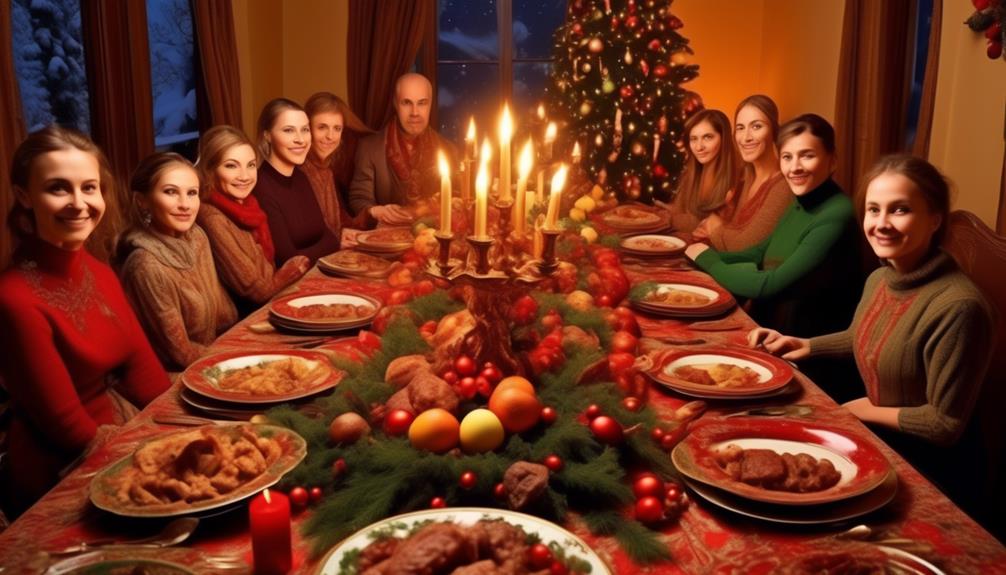
You may be curious why Ukrainian Christmas is celebrated on January 7th.
Well, the answer lies in a fascinating historical and cultural phenomenon that has shaped the way Ukrainians celebrate this important holiday.
The reasoning behind this may surprise you and shed light on the unique traditions and customs that make Ukrainian Christmas so intriguing.
Key Takeaways
- Ukrainian Christmas falls on January 7 according to the Gregorian calendar.
- The shift from the Julian to the Gregorian calendar influenced the date of Ukrainian Christmas.
- The Orthodox Church's influence shapes the date of Christmas in Ukraine.
- Ukrainian Christmas traditions reflect the rich heritage and customs passed down through generations.
Julian Calendar Vs. Gregorian Calendar
The Julian calendar and the Gregorian calendar are two distinct systems for organizing and calculating dates.
The Julian calendar, introduced by Julius Caesar in 45 BCE, was based on a 365-day year with an extra day added every four years. However, this method overestimated the solar year by 11 minutes and 14 seconds, resulting in a gradual shift from the actual solar year.
This inaccuracy led to the need for a calendar reform, which was addressed by the introduction of the Gregorian calendar in 1582 by Pope Gregory XIII. The Gregorian calendar adjusted the leap year rule, omitting the leap year three times every 400 years to bring the calendar year more in line with the solar year. This change improved the calendar's accuracy and corrected the discrepancy caused by the Julian calendar.
The historical calendar reforms initiated by the Gregorian calendar have been widely adopted, and it's the calendar system most commonly used today.
The shift from the Julian to the Gregorian calendar demonstrates the continuous efforts to refine and improve the accuracy of our timekeeping system.
Origin of the Julian Calendar

Having studied the need for calendar reform, I discovered the origin of the Julian calendar lies in the efforts of Julius Caesar to rectify the discrepancies in the previous Roman calendar. The Julian calendar was introduced in 45 BCE and was a reform of the Roman calendar. It was designed to correct the errors of the earlier system, particularly the misalignment of the calendar year with the solar year. The calendar was named after Julius Caesar and implemented by the astronomer Sosigenes. The Julian calendar was a significant step forward in the organization of timekeeping, as it established the 365-day year and a leap year occurring every four years.
| Julian Calendar Origins | Calendar Reform Impact | Historical Significance |
|---|---|---|
| Introduced in 45 BCE by Julius Caesar | Aligned the calendar year with the solar year | Laid the groundwork for the modern Gregorian calendar |
| Corrected errors of the earlier Roman calendar | Established the 365-day year | Improved agricultural planning and astronomical accuracy |
| Named after Julius Caesar | Implemented by astronomer Sosigenes | Influenced the development of timekeeping globally |
The Julian calendar's origins and its impact on calendar reform have had a lasting influence on how we organize and understand time.
Adoption of the Gregorian Calendar
After rectifying the discrepancies in the Julian calendar, the need for further adjustments led to the adoption of the Gregorian calendar in 1582. This shift had a profound impact on the way we celebrate cultural and religious events.
Here are some insights into the adoption of the Gregorian calendar:
- Calendar Change Impact: The adoption of the Gregorian calendar aimed to more accurately align the calendar year with the solar year, correcting the miscalculations of the Julian calendar.
- Liturgical Calendar Alignment: The Gregorian calendar's introduction also sought to align the liturgical calendar with the solar calendar, ensuring that religious festivals and observances occurred at the appropriate times of the year.
- Regional Variations: The adoption of the Gregorian calendar wasn't uniform across all regions, leading to variations in the adoption and the observance of cultural celebrations based on the calendar shift.
- Modern Day Observance: Today, the Gregorian calendar is widely used, influencing the scheduling of holidays, events, and daily life globally, bringing historical religious influence into modern-day observance.
The adoption of the Gregorian calendar continues to shape our lives, influencing how we mark time and celebrate important cultural and religious occasions.
Impact on Christmas Date
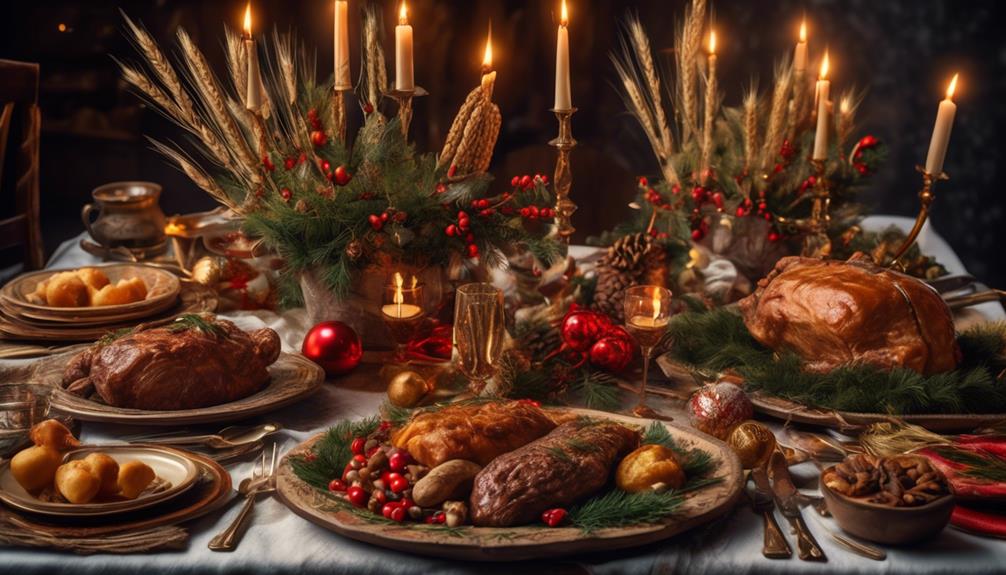
So, the shift to the Gregorian calendar had a significant impact on the date of Ukrainian Christmas. This change resulted in the celebration moving from January 6 to January 7, aligning with the Orthodox tradition.
The historical calendar shift and the influence of Orthodox traditions have played a crucial role in shaping the date of Ukrainian Christmas.
Historical Calendar Change
The historical calendar change significantly impacted the date of Christmas, leading to the celebration of Ukrainian Christmas on January 7. This change, driven by calendar reform and astronomical alignment, brought about several noteworthy effects:
- Shift in Celebration: The adjustment in the calendar moved the date of Christmas to January 7 in the Julian calendar, which is currently observed by Ukrainian Orthodox and Greek Orthodox churches.
- Discrepancy with Western Christmas: As a result of the calendar change, Ukrainian Christmas occurs 13 days after the traditional December 25 celebration in the Gregorian calendar, creating a distinction from Western Christmas.
- Cultural Traditions: The shift in the Christmas date influenced the customs and rituals associated with Ukrainian Christmas, making it a unique and culturally significant event.
- Historical Significance: The historical calendar change not only altered the date of Christmas but also holds significance in shaping Ukrainian traditions and religious practices.
Influence of Orthodox Tradition
In adherence to Orthodox tradition, the celebration of Ukrainian Christmas on January 7 reflects the historical and religious significance of the Julian calendar. The Orthodox Church follows the Julian calendar, which is 13 days behind the Gregorian calendar used by Western Christianity. This discrepancy results in Ukrainian Christmas falling on January 7 according to the Gregorian calendar.
Orthodox customs play a pivotal role in shaping the date of Christmas, emphasizing the cultural significance of the event. The influence of Orthodox tradition underscores the deep-rooted customs and practices that have been passed down through generations, adding richness and depth to the celebration of Christmas.
Understanding the impact of Orthodox tradition on the date of Ukrainian Christmas allows for a deeper appreciation of the cultural and religious elements that make this holiday unique and meaningful.
Eastern Orthodox Church Influence
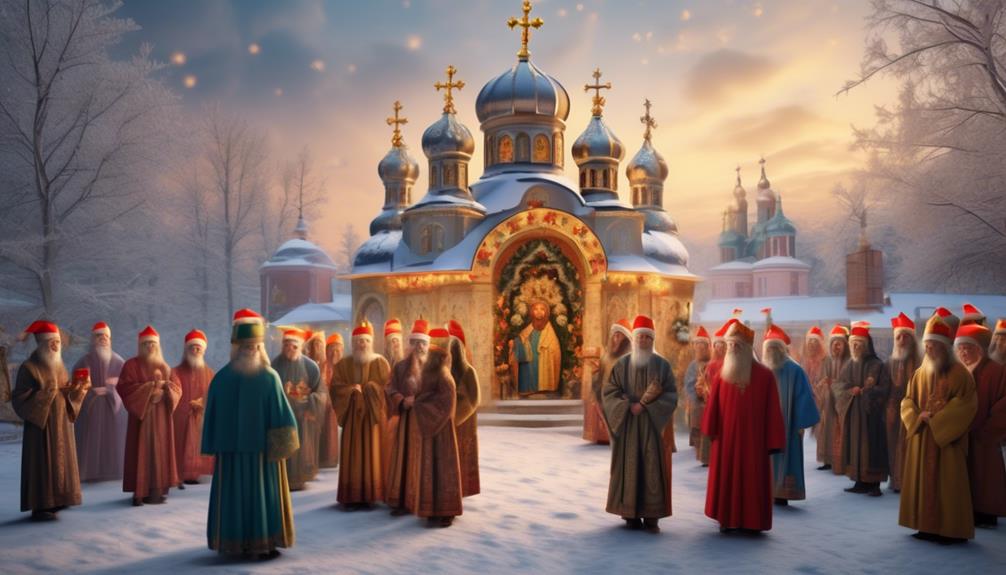
The Eastern Orthodox Church has had a significant influence on the date of Ukrainian Christmas, aligning it with the liturgical calendar and historical Byzantine tradition.
This influence has played a key role in shaping the unique customs and practices associated with Ukrainian Christmas celebrations.
Understanding this influence is crucial in appreciating the rich cultural and religious significance of the holiday.
Liturgical Calendar Alignment
Celebrating Ukrainian Christmas on January 7 aligns with the liturgical calendar of the Eastern Orthodox Church, reflecting its influence on the traditions and practices of the Ukrainian people. This historical alignment holds deep religious significance for us, as it honors the date of Christ's birth according to the Julian calendar, which is still used by the Eastern Orthodox Church.
The calendar discrepancy between the Julian and Gregorian calendars has led to this unique date for Ukrainian Christmas, enriching our cultural celebrations with a sense of historical continuity and spiritual significance. This alignment also fosters a strong sense of unity and community among Ukrainians, as we come together to honor our religious heritage and celebrate the birth of Christ in accordance with our rich Orthodox traditions.
Historical Byzantine Tradition
Drawing from our deep historical ties to the Byzantine tradition, the influence of the Eastern Orthodox Church has left a lasting impact on the customs and practices surrounding Ukrainian Christmas. The Byzantine traditions, which form the foundation of the Eastern Orthodox Church, have significantly shaped the way Ukrainians celebrate Christmas. These traditions have been preserved and passed down through generations, contributing to the historical significance of Ukrainian Christmas on January 7.
| Byzantine Traditions | Historical Significance |
|---|---|
| Iconography | Symbolism and reverence |
| Liturgical Chants | Spiritual connection |
| Fasting and Feasting | Communal traditions |
| Candlelight Vigils | Reflective atmosphere |
The incorporation of Byzantine traditions has not only enriched the spiritual aspects of the holiday but also created a strong sense of cultural identity for Ukrainian communities around the world.
Ukrainian Christmas Traditions

Ukrainian Christmas traditions hold a special place in our culture, reflecting the rich heritage and customs passed down through generations. These traditions bring us together and create a sense of warmth and belonging during the holiday season.
Here are a few beloved Ukrainian Christmas traditions that continue to shape our celebrations:
- Traditional Decorations: Adorning our homes with intricately designed pysanky (Ukrainian Easter eggs) and festive wreaths made of hay and adorned with ribbons is a cherished tradition. These decorations symbolize prosperity, protection, and the coming of spring.
- Festive Feasting: Christmas Eve, known as Sviaty Vechir, is a time for a grand feast centered around 12 meatless dishes, representing the 12 apostles. Kutia, a sweet wheat pudding, is a staple dish, and the sharing of a blessed loaf of bread, or kolach, is a symbol of unity and goodwill.
- Caroling: Ukrainian Christmas traditions include caroling from home to home, with groups of children and adults singing traditional carols to spread joy and good fortune.
- Holy Supper: The Holy Supper on Christmas Eve begins with the lighting of a candle, symbolizing the light of Christ, and the breaking of bread, a custom that fosters unity and goodwill among family members.
Historical Significance
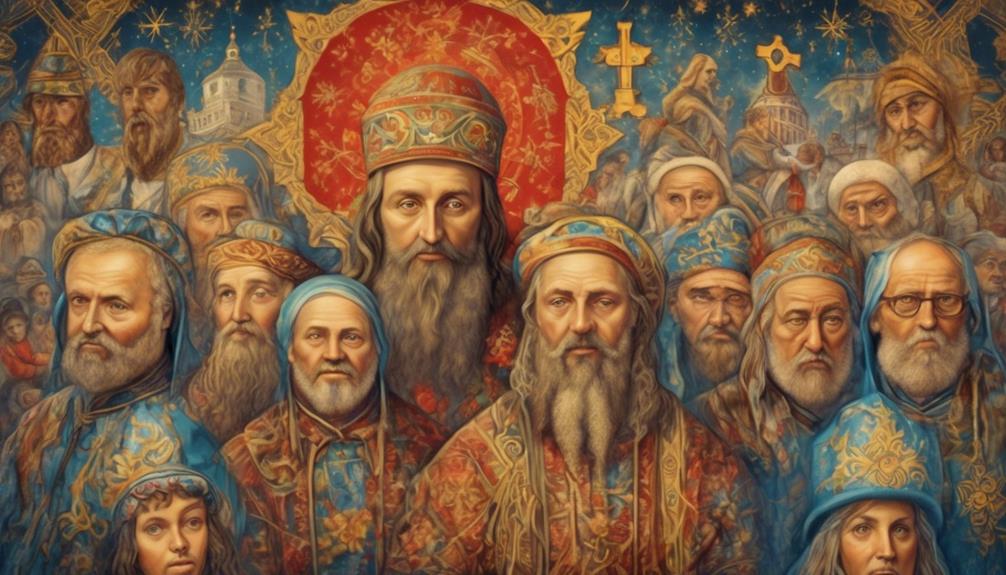
Having explored the cherished Ukrainian Christmas traditions, we now turn our attention to the historical significance that underpins these cultural practices.
The impact on traditions and the cultural significance of Ukrainian Christmas on January 7 can be traced back to the Christianization of the region. In 988 AD, Grand Prince Vladimir the Great of Kiev adopted Christianity as the state religion of Kievan Rus, which included modern-day Ukraine. This decision to embrace Orthodox Christianity from the Byzantine Empire laid the foundation for the customs and rituals that are still observed during Ukrainian Christmas today.
The shift to the Julian calendar by the Orthodox Church further solidified the date of Ukrainian Christmas on January 7. This change had a lasting influence on the religious and cultural fabric of Ukraine, shaping the unique way in which Christmas is celebrated in the country.
The historical significance of these events continues to resonate through the centuries, influencing the traditions and practices that are cherished by Ukrainians around the world. Understanding this historical context adds depth and richness to the cultural significance of Ukrainian Christmas, providing insight into the enduring legacy of these age-old traditions.
Winter Solstice Connection
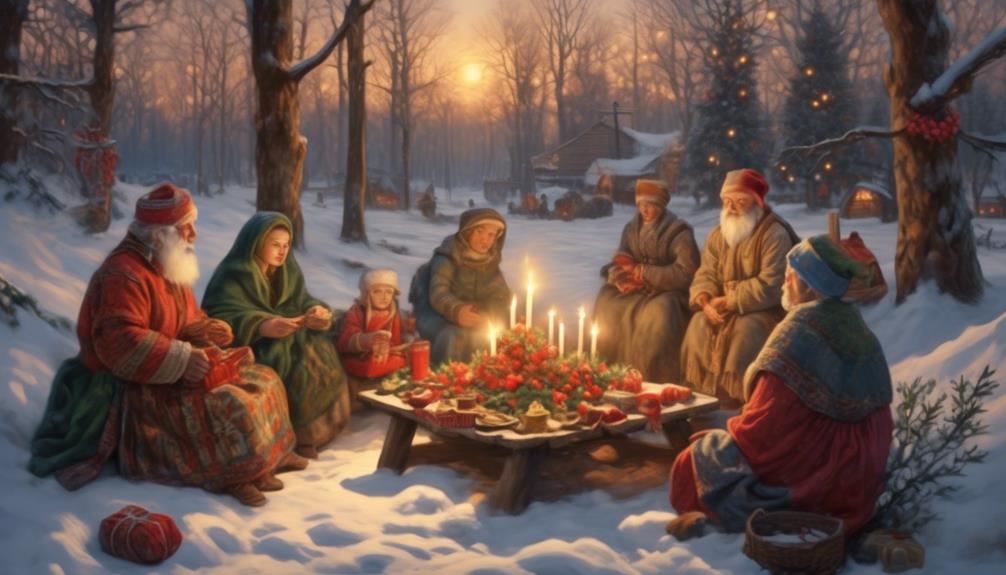
We can see a fascinating connection between Ukrainian Christmas on January 7 and the Winter Solstice.
The shift in the solar calendar aligns with the Christian Orthodox tradition, marking the birth of Jesus Christ.
This connection reflects the cultural and historical significance of Ukrainian Christmas celebrations.
Solar Calendar Shift
Traditionally celebrated on January 7, Ukrainian Christmas aligns with the shift in the solar calendar, marking the winter solstice. This astronomical alignment deeply influences our seasonal celebrations, shaping the traditions and customs we hold dear.
Here's why this solar calendar shift is so significant to us:
- Connection to Nature: The solar calendar shift reflects our connection to the natural world, emphasizing the importance of the changing seasons in our cultural traditions.
- Symbolic Meanings: The winter solstice holds symbolic meanings of rebirth and renewal, which are intricately woven into our Christmas festivities.
- Harvest and Planting: The solar calendar shift also influences our agricultural practices, guiding us in the timing of planting and harvesting.
- Family and Community: This celestial event brings our families and communities together, fostering a sense of unity and shared purpose during the holiday season.
Christian Orthodox Tradition
Celebrating Ukrainian Christmas on January 7 incorporates Christian Orthodox traditions into our winter solstice festivities, creating a meaningful connection to our faith and cultural heritage. Christian Orthodox practices reflect the deep roots of our cultural significance, intertwining religious beliefs with the changing of seasons. The winter solstice holds great importance in many ancient cultures, symbolizing the triumph of light over darkness and the promise of new beginnings. This connection to the natural world is echoed in our Orthodox practices, underscoring the harmony between our faith and the cyclical rhythms of nature. By observing Ukrainian Christmas on January 7, we honor our ancestors' wisdom and the enduring traditions that have sustained us for generations.
| Orthodox Practices | Cultural Significance |
|---|---|
| Fasting and Prayer | Connecting with Ancestors |
| Divine Liturgy | Embracing Tradition |
| Symbolism in Rituals | Honoring the Natural World |
Cultural Celebrations
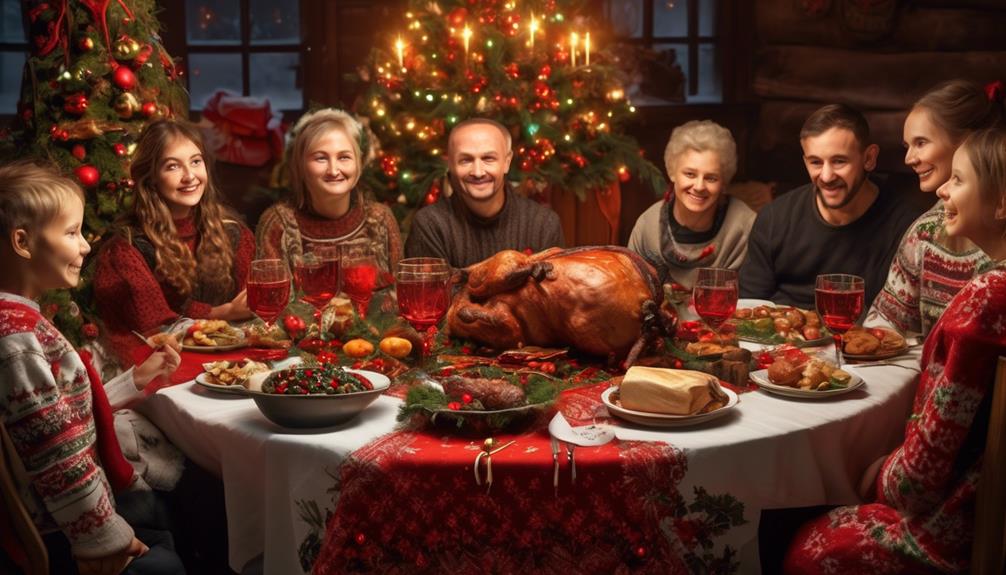
Ukrainian Christmas on January 7 is a vibrant and significant cultural celebration in Ukraine. It's a time when our traditions come alive, filling the air with joy and warmth. Here are a few aspects that make this celebration so special to us:
- Traditional customs:
From caroling to the making of special Christmas ornaments, our customs are deeply rooted in our history and are passed down through generations. It's a time when we gather with family and friends to partake in these meaningful traditions.
- Festive foods:
Christmas Eve, known as Sviat Vechir, is a time when we feast on twelve meatless dishes, symbolizing the twelve apostles. Each dish holds its own significance and is prepared with love and care. The meal brings us together and reminds us of our shared heritage.
- Symbolic rituals:
The lighting of candles, the breaking of bread, and the singing of traditional carols all hold deep symbolism and meaning. These rituals connect us to our ancestors and affirm our cultural identity.
- Community gatherings:
Ukrainian Christmas is a time when communities come together to celebrate with music, dance, and laughter. It's a time of unity and shared joy, where we strengthen our bonds with one another.
Worldwide Observance
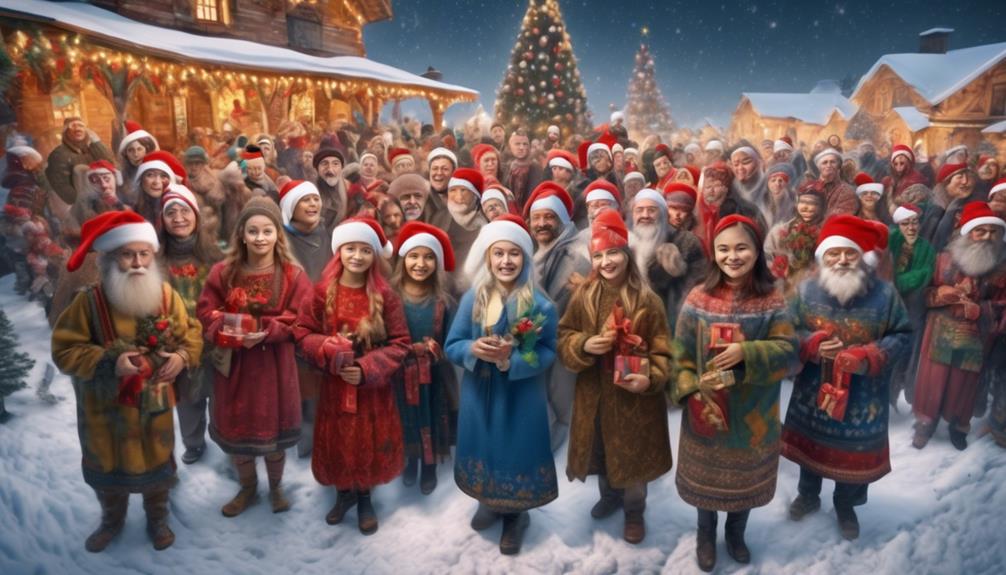
As we reflect on the vibrant and significant cultural celebration of Ukrainian Christmas on January 7, it becomes clear that its traditions and customs aren't confined to Ukraine alone, but are also embraced and observed worldwide. The cultural significance and traditional rituals of Ukrainian Christmas have transcended borders, resonating with people of diverse backgrounds across the globe. This global impact is a testament to the universal appeal of the holiday's rich customs, which have been integrated into the tapestry of various cultures.
The observance of Ukrainian Christmas on January 7 reflects the religious diversity present in many countries. In regions where Eastern Orthodox Christianity is practiced, such as Russia, Serbia, and Greece, the traditions of Ukrainian Christmas are shared and celebrated with fervor. Additionally, in multicultural societies, the holiday has found a place among the array of festive observances, showcasing the beauty of unity in diversity.
The widespread observance of Ukrainian Christmas serves as a reminder of the interconnectedness of humanity and the power of cultural exchange. It's heartening to witness the global embrace of these traditions, further enriching the tapestry of cultural celebrations around the world.
Symbolism and Customs
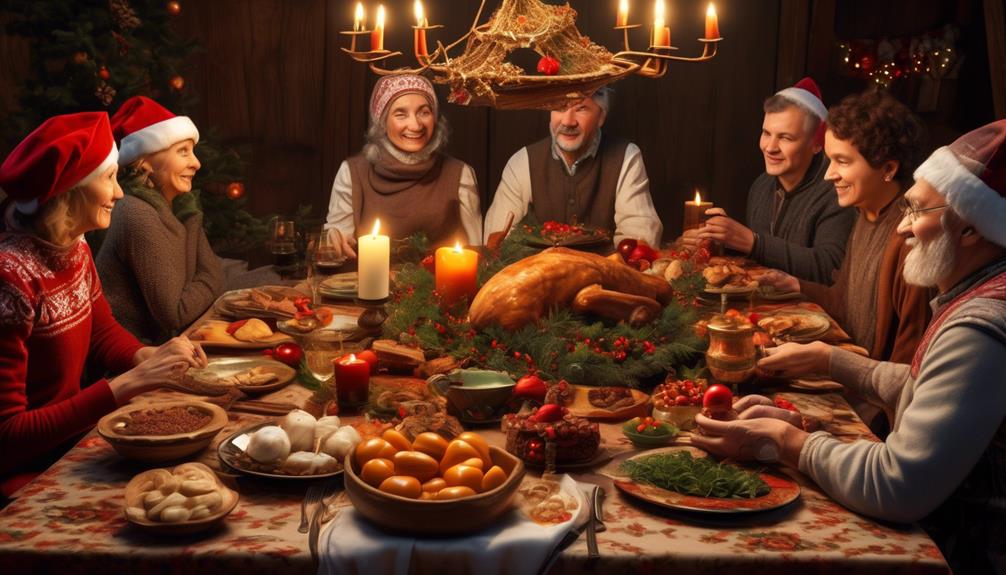
Incorporating symbolic elements and age-old customs, Ukrainian Christmas embodies the richness of tradition and spirituality. Here are some of the symbolic rituals and festive foods that make Ukrainian Christmas a truly special and meaningful celebration:
- Symbolic Rituals: On Christmas Eve, a solemn and symbolic ritual takes place where the family gathers for a twelve-course meatless meal, representing the twelve apostles. Each dish holds its own significance, such as kutia, a sweet wheat pudding symbolizing peace and good health.
- Didukh: This is an important Ukrainian Christmas tradition where a sheaf of wheat, symbolizing the importance of the harvest, is placed in the center of the dining table. It represents the spirit of the ancestors and is a reminder of their presence during the celebration.
- Festive Foods: Throughout the Christmas season, traditional Ukrainian foods like borscht, varenyky (stuffed dumplings), and holubtsi (stuffed cabbage rolls) are prepared with love and care, each carrying its own symbolism and history.
- Caroling and Koliadky: Another cherished tradition involves caroling, where groups of young people visit homes, singing traditional Ukrainian Christmas carols called koliadky, spreading joy and good wishes for the coming year.
Regional Variations

Embracing the diversity of traditions and customs, regional variations in Ukrainian Christmas celebrations reflect the unique cultural influences and practices of different areas across Ukraine. These regional differences highlight the rich tapestry of Orthodox customs and winter celebrations.
In Western Ukraine, for instance, there's a strong tradition of caroling from house to house, known as 'koliadky.' This custom involves young people dressing up in traditional attire and visiting homes to sing carols, spreading the joy of the season.
In central and eastern parts of Ukraine, a special dish called 'kutia' holds significant cultural significance during the Christmas Eve dinner. This sweet wheat pudding, often mixed with honey and poppy seeds, symbolizes prosperity and the cycle of life.
Furthermore, in the southern regions, the Christmas Eve supper might include a greater variety of fish dishes due to the proximity to water bodies.
These regional variations not only add color to the festivities but also offer a glimpse into the diverse cultural heritage of Ukraine. The amalgamation of these unique practices contributes to the richness and depth of Ukrainian Christmas celebrations, making it a truly captivating and meaningful experience.
Modern Day Observance
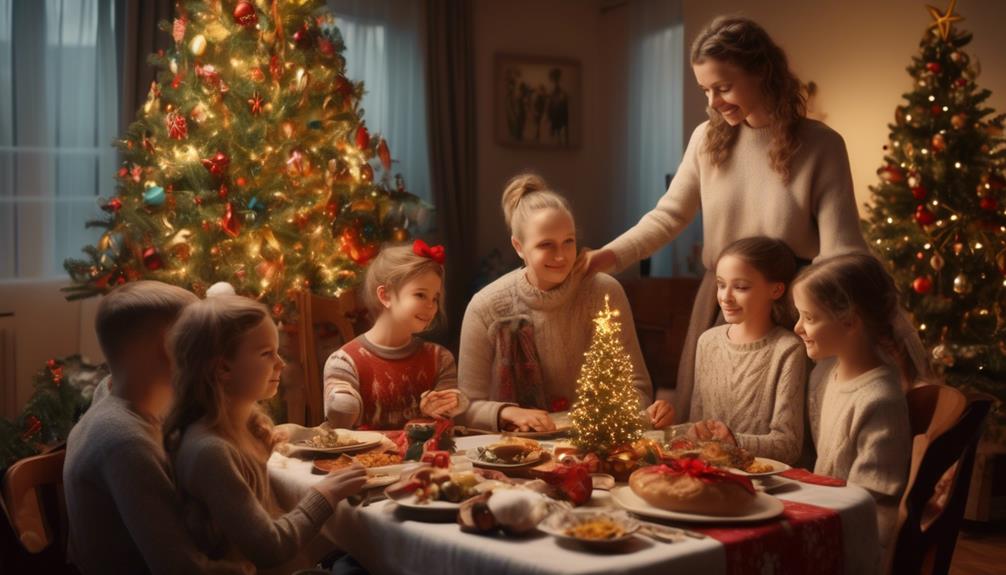
We observe Ukrainian Christmas on January 7 in accordance with the Orthodox Christian tradition.
The discrepancy between the Julian calendar and the Gregorian calendar plays a significant role in the modern-day observance of Ukrainian Christmas.
Additionally, the historical religious influence on the celebration continues to shape the way it's observed in contemporary times.
Orthodox Christian Tradition
How do Orthodox Christians in Ukraine observe their Christmas traditions on January 7?
In Ukraine, Orthodox traditions are deeply rooted in the celebration of Christmas on January 7. Here's how we honor this special day in our culture:
- Fasting and Prayer: Leading up to Christmas, many Orthodox Christians fast as a way to prepare their hearts and minds for the celebration of the birth of Christ.
- Midnight Liturgy: On the eve of January 7, families gather at churches for a midnight liturgy. The services are filled with beautiful hymns and prayers, creating a sense of reverence and anticipation.
- Traditional Meals: After the Christmas Day liturgy, families come together to enjoy a festive meal. Traditional dishes such as kutia (sweet wheat pudding) and borscht are commonly served, symbolizing prosperity and the hope for a bountiful year.
- Caroling and Community: It's a time for caroling and visiting friends and family, spreading joy and good wishes throughout the community. This fosters a sense of togetherness and warmth, making Christmas a truly special time for Orthodox Christians in Ukraine.
Julian Calendar Discrepancy
Taking into account the Julian calendar discrepancy, Orthodox Christians in Ukraine celebrate Christmas on January 7th, a date that differs from the widely observed December 25th. The difference in dates stems from the use of the Julian calendar for religious observance. The Julian calendar, introduced by Julius Caesar in 46 BC, was reformed by Pope Gregory XIII in 1582, leading to the adoption of the Gregorian calendar in most of the world. However, Orthodox churches, including the Ukrainian Orthodox Church, continue to use the Julian calendar for religious celebrations. This calendar reform resulted in a 13-day difference between the Julian and Gregorian calendars, causing Orthodox Christmas to be observed on January 7th. This adherence to the Julian calendar exemplifies the deep-rooted traditions and religious observances within the Ukrainian Orthodox Christian community.
| Julian Calendar | Gregorian Calendar |
|---|---|
| January 7 | December 25 |
Historical Religious Influence
The historical religious influence of the Julian calendar on the modern-day observance of Orthodox Christmas in Ukraine underscores the enduring traditions and religious customs within the Ukrainian Orthodox Christian community.
Our religious practices are deeply rooted in history, and the adoption of the Julian calendar by the Ukrainian Orthodox Church has shaped the way we celebrate Christmas.
The calendar discrepancy between the Julian and Gregorian calendars has led to the unique observance of Christmas on January 7.
This religious influence highlights the preservation of our cultural identity and spiritual heritage.
It fosters a sense of unity and continuity, connecting us to our ancestors and the early Christian traditions that have been cherished for generations.
Our observance of Christmas on January 7 embodies the profound religious influence that has endured throughout Ukrainian history.
The Spirit of Ukrainian Christmas

Celebrating Ukrainian Christmas is a joyous occasion filled with traditions, delicious food, and a strong sense of community. Ukrainian caroling, known as 'Koliadnyky,' is a heartwarming tradition where groups of people go from house to house singing traditional Christmas carols. It creates a lively and festive atmosphere, spreading joy and merriment throughout the community.
The festive cuisine traditions are another integral part of Ukrainian Christmas. From the twelve-dish Holy Supper on Christmas Eve to the various sweet breads and pastries, every dish holds special significance and is prepared with love and care. The act of preparing these meals brings families together and fosters a deep sense of togetherness and sharing. The aroma of traditional dishes like kutia, borscht, and varenyky fills the air, creating an atmosphere of warmth and comfort.
The spirit of Ukrainian Christmas isn't just about the religious significance, but also about the strong cultural and communal bonds it fosters. It's a time to come together, celebrate old traditions, and create new memories with loved ones.
Frequently Asked Questions
What Are Some Traditional Ukrainian Dishes Served During Christmas?
During Ukrainian Christmas, we prepare traditional festive dishes that are central to our cuisine. Some popular recipes include kutia, a sweet grain pudding, and borscht, a hearty beet soup.
Other favorites are varenyky, dumplings filled with various ingredients, and holubtsi, cabbage rolls stuffed with rice and meat.
These dishes are essential for a delicious and meaningful Christmas meal, showcasing our rich Ukrainian culinary traditions.
How Do Ukrainians Typically Decorate Their Homes for Christmas?
We love decorating our homes for Christmas! We typically use colorful ornaments and handmade decorations to create a festive atmosphere. It's a beautiful tradition that brings warmth and joy to our homes.
The vibrant colors and intricate designs of the decorations add a special touch to our celebrations. It's a time for gathering with loved ones and creating a cozy and inviting space for the holiday season.
What Are Some Unique Ukrainian Christmas Traditions That Are Not Widely Known?
Ukrainian Christmas traditions are rich with festive folklore and folk customs. We celebrate with traditional holiday activities that aren't widely known.
Some unique traditions include the making of didukh, a sheaf of wheat symbolizing the importance of the harvest, and caroling called 'koliadky'.
We preserve these traditions to honor our heritage and bring joy to our homes during the holiday season.
Are There Any Specific Ukrainian Christmas Songs or Carols That Are Commonly Sung During the Holiday?
During Ukrainian Christmas, we often sing traditional carols called 'koliadky' and 'shchedrivky.' These songs are deeply rooted in Ukrainian folklore and customs, with lyrics that celebrate the birth of Jesus and bring blessings to households.
The melodies and lyrics vary by region, but they all hold a special place in our hearts. Singing these carols is a cherished tradition that brings joy and unity to our celebrations.
What Are Some Modern-Day Adaptations of Ukrainian Christmas Celebrations in Urban Areas Versus Rural Areas?
In urban areas, Ukrainian Christmas celebrations often see modern adaptations with community gatherings and festive events.
Meanwhile, in rural areas, the focus remains on preserving and passing down cherished family traditions.
The urban setting fosters a sense of togetherness and communal celebration, while the rural setting emphasizes the intimate and time-honored customs within families.
Both settings beautifully reflect the enduring spirit of Ukrainian Christmas.
Why is there a difference in Christmas traditions and dates between Ukraine and Russia?
The difference in Christmas traditions and dates between Ukraine and Russia can be attributed to historical, religious, and cultural factors. Ukrainian Christmas falls on January 7th, following the Julian calendar, while Russian Christmas is celebrated on December 25th. Understanding these differences provides valuable insights into Russian Christmas traditions.
Conclusion
In conclusion, Ukrainian Christmas falls on January 7 due to the use of the Julian calendar by the Eastern Orthodox Church. This date holds deep symbolism and customs for Ukrainians, and the spirit of Ukrainian Christmas is a time of joy, tradition, and celebration.
So next time you wonder why Ukrainian Christmas is on January 7, remember the rich history and cultural significance behind this special holiday.
- About the Author
- Latest Posts
Introducing Ron, the home decor aficionado at ByRetreat, whose passion for creating beautiful and inviting spaces is at the heart of his work. With his deep knowledge of home decor and his innate sense of style, Ron brings a wealth of expertise and a keen eye for detail to the ByRetreat team.
Ron’s love for home decor goes beyond aesthetics; he understands that our surroundings play a significant role in our overall well-being and productivity. With this in mind, Ron is dedicated to transforming remote workspaces into havens of comfort, functionality, and beauty.
Chinese New Year Decorations
What Is the Symbol for Orthodox Christmas?
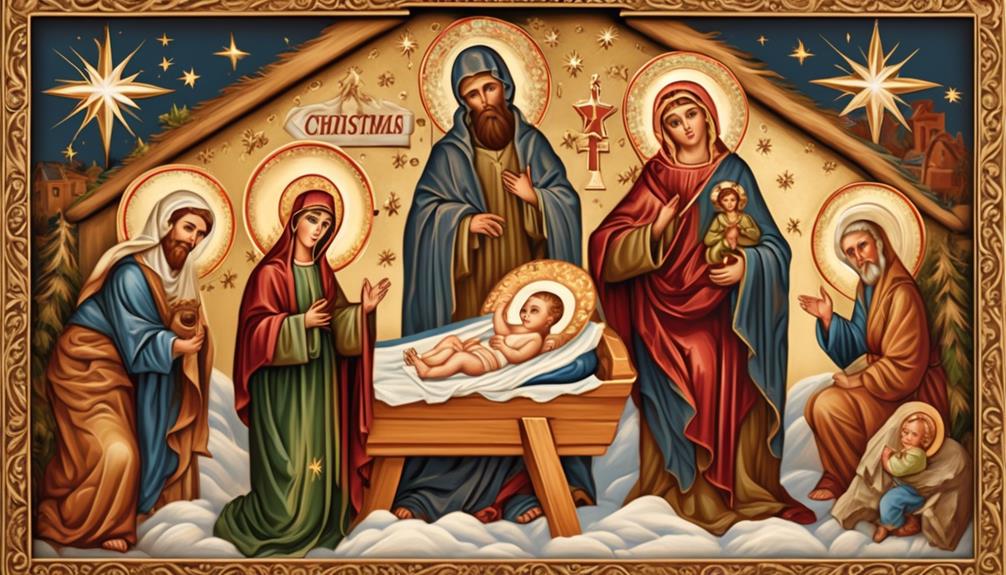
Have you ever thought about the symbol for Orthodox Christmas?
There are various theories and interpretations surrounding this topic, each shedding light on the rich cultural and historical significance behind the symbol.
As we explore the origins and meaning of this symbol, we will uncover its deep-rooted connections to Orthodox faith and its role in global celebrations.
Stay tuned to unravel the mysteries and traditions associated with this iconic symbol.
Key Takeaways
- The symbol for Orthodox Christmas is known as the Nativity icon.
- The Nativity icon represents the birth of Jesus Christ and holds profound symbolic origins.
- The icon conveys the theological truths of the Incarnation, emphasizing the divine and human nature of Jesus Christ.
- The Nativity icon is deeply embedded in the cultural fabric of many communities and represents hope, love, and the unity of families and communities during the holiday season.
Origins of the Symbol
The symbol for Orthodox Christmas, known as the Nativity icon, has its origins deeply rooted in the rich traditions and religious significance of the Eastern Orthodox Church. This iconic representation of the birth of Jesus Christ holds profound symbolic origins, reflecting the theological and spiritual beliefs of the Orthodox Christian faith. The Nativity icon isn't merely a depiction of the birth of Jesus, but it encompasses a wealth of theological meanings and spiritual significance that are central to Orthodox Christian theology.
The symbolic origins of the Nativity icon can be traced back to the early centuries of Christianity, where the visual representation of biblical events became an integral part of Christian worship and devotion. The Nativity icon, through its intricate symbolism and artistic depiction, conveys the theological truths of the Incarnation, emphasizing the divine and human nature of Jesus Christ.
It serves as a visual proclamation of the central beliefs of Orthodox Christianity, encapsulating the profound religious significance of Christmas within its sacred imagery.
Cultural Significance
Rooted in the rich traditions and religious significance of the Eastern Orthodox Church, the Nativity icon holds profound cultural significance that extends beyond its theological and spiritual meanings. The symbolic traditions associated with Orthodox Christmas are deeply embedded in the cultural fabric of many communities.
The Nativity icon, with its depictions of the birth of Jesus, not only serves as a religious symbol but also carries immense cultural weight. Its imagery is often intertwined with festive symbolism, representing hope, love, and the unity of families and communities during the holiday season.
The cultural significance of the Nativity icon is also intertwined with various religious interpretations. It serves as a visual representation of the religious narrative of the birth of Jesus, conveying the central themes of the Orthodox Christmas celebration. The icon's portrayal of the Nativity scene, along with the figures of Mary, Joseph, and the newborn Jesus, holds deep cultural and religious meaning for Orthodox Christians.
The Nativity icon, through its cultural significance and religious interpretations, continues to be a unifying symbol during Orthodox Christmas, fostering a sense of shared identity and tradition within these communities.
Symbolic Representation
Embedded in the cultural fabric and religious traditions of the Eastern Orthodox Church, the Nativity icon holds profound symbolic significance for Orthodox Christmas. Symbolic representation in Orthodox Christianity is rich and deeply rooted in tradition.
The Nativity icon, depicting the birth of Jesus Christ, is a powerful symbol that encapsulates the essence of the Orthodox Christmas. The icon is adorned with religious symbolism, portraying the Virgin Mary, the infant Jesus, the adoration of the shepherds, and the visitation of the Magi. Each element in the icon carries specific religious significance, offering a visual representation of the theological beliefs surrounding the birth of Christ.
In contrast to other Christian denominations, Orthodox symbolism often emphasizes the mystery and transcendence of divine events. The Nativity icon, through its intricate symbolism, invites believers to contemplate the spiritual truths of Christmas, fostering a deep sense of reverence and awe.
The symbolic representation in Orthodox Christmas serves as a profound reminder of the divine significance of the Incarnation, inviting believers to meditate on the sacred mysteries of the faith.
Traditional Iconography
In exploring the significance of Orthodox Christmas, the traditional iconography of the Nativity holds a pivotal role in conveying the rich symbolism and spiritual depth of this religious observance. Traditional art in Orthodox Christianity plays a profound role in depicting the Nativity, often focusing on religious symbolism to convey the divine aspects of the birth of Jesus Christ. The traditional iconography of the Nativity typically includes the Virgin Mary, the infant Jesus, and Joseph, often surrounded by shepherds, angels, and the Star of Bethlehem. Each element is meticulously crafted to symbolize profound spiritual truths and convey the significance of the event.
Comparatively, traditional iconography in Orthodox Christmas art often differs from Western Christian depictions. The emphasis on religious symbolism and the use of rich, vibrant colors in Orthodox iconography are distinctive features that set it apart. The careful attention to detail and adherence to specific artistic traditions further enhance the spiritual depth of these representations. Through traditional iconography, Orthodox Christmas art continues to serve as a powerful medium for believers to connect with the sacred narrative of the Nativity and its enduring significance.
Historical Evolution
As we explore the historical evolution of the symbol for Orthodox Christmas, it's important to consider its symbolic significance and the cultural variations that have emerged over time.
By analyzing the changes in the depiction of this symbol across different historical periods and cultural contexts, we can gain valuable insights into its evolving meaning and relevance.
Through a comparative lens, we can also examine how various traditions and interpretations have shaped the symbol's representation in diverse Orthodox communities.
Symbolic Significance
The symbolic significance of the Orthodox Christmas has evolved over centuries, reflecting a rich tapestry of historical, cultural, and religious influences. In the Orthodox tradition, symbolic representation is deeply intertwined with religious customs, each carrying profound meaning and significance. The table below provides a comparative analysis of the symbolic significance of Orthodox Christmas in various cultures and traditions.
| Symbolic Representation | Religious Custom |
|---|---|
| Nativity Icon | Fasting |
| Twelve Lenten Dishes | Midnight Liturgy |
| Yule Log | Holy Communion |
| Star of Bethlehem | Caroling |
| Angels | Epiphany |
These symbols and customs are not only a reflection of historical traditions but also serve to deepen the spiritual significance of Orthodox Christmas, providing a sense of intimacy and reverence for believers around the world.
Cultural Variations
The evolution of the symbolic significance of Orthodox Christmas is evident in the diverse cultural variations and historical influences that have shaped the celebration over time.
Cultural practices and holiday customs associated with Orthodox Christmas vary widely across different regions where it's celebrated. For instance, in some Eastern European countries, the holiday is marked with a twelve-course meatless Christmas Eve supper, while in others, it's customary to attend midnight church services.
Additionally, historical influences such as the Byzantine and Ottoman empires have contributed to the unique customs and traditions observed during Orthodox Christmas. These cultural variations highlight the rich tapestry of customs and practices that have developed over centuries, showcasing the diversity and depth of the celebration of Orthodox Christmas across different regions and communities.
Symbol's Religious Meaning
Celebrated by Orthodox Christians, the symbol of the Christmas holiday holds deep religious significance. The symbol's interpretation varies across different Orthodox Christian traditions, yet the religious significance remains central.
In the Eastern Orthodox Church, the primary symbol of Orthodox Christmas is the Nativity icon, depicting the birth of Jesus Christ in Bethlehem. This icon serves as a visual representation of the religious significance of the holiday, reminding believers of the central event in Christian theology. The Nativity icon often includes symbolic elements such as the cave where Christ was born, the manger, the Star of Bethlehem, and the presence of angels and shepherds, all of which carry profound religious meanings.
In contrast, other Orthodox traditions may emphasize different symbols, such as the Yule log in some Eastern European cultures, yet the religious significance of these symbols remains connected to the birth of Jesus Christ.
Despite variations in the symbols used to celebrate Orthodox Christmas, the religious meaning underlying these symbols serves to unite Orthodox Christians in their shared faith and devotion to the Nativity of Christ.
Regional Variations
Regional variations in the observance of Orthodox Christmas introduce diverse customs and practices that reflect the rich cultural tapestry of Orthodox Christian communities worldwide. Symbolic attire and ritual practices hold significant importance in the celebration of Orthodox Christmas, and the variations in these aspects further highlight the unique traditions within different regions.
| Region | Symbolic Attire | Ritual Practices |
|---|---|---|
| Russia | Traditional embroidered clothing, such as sarafans and kokoshniks, symbolizing the country's rich cultural heritage and history. | The Christmas Eve meal, known as Holy Supper, is a central ritual consisting of 12 meatless dishes, symbolizing the 12 apostles, and is accompanied by prayers and carol singing. |
| Greece | Garments featuring intricate designs and patterns, representing the country's deep-rooted connection to Byzantine art and religious symbolism. | The lighting of the Christmas boat, symbolizing the birth of Christ and the sea-faring traditions of the Greek people, is a significant ritual observed in coastal regions. |
| Ethiopia | White traditional garments symbolizing purity and renewal, often adorned with intricate patterns and colors. | The three-day fast, known as 'Gahad of the Fast', precedes Christmas and is followed by attending a colorful and vibrant church service on Christmas Eve. |
These regional variations not only add depth to the observance of Orthodox Christmas but also foster a sense of unity and understanding among Orthodox Christian communities around the world.
Symbol in Art and Decor
Symbolism in Orthodox Christmas art and decor plays a significant role in conveying the rich cultural and religious heritage of Orthodox Christian communities worldwide. Artistic interpretations often feature religious motifs such as the Nativity scene, depicting the birth of Jesus Christ, and the Adoration of the Magi, symbolizing the visit of the Three Wise Men. These artistic representations aren't only decorative but also carry deep spiritual significance, reminding believers of the core tenets of their faith.
Additionally, decorative symbolism in Orthodox Christmas art frequently includes elements like the use of gold and silver, symbolizing the divine and eternal nature of Christ, and the presence of angels, symbolizing the messengers of God who announced the birth of Jesus.
Comparatively, Orthodox Christmas art and decor may differ in style and specific symbols based on regional traditions and cultural influences. For example, in Eastern Orthodox traditions, icons are a prominent feature, serving as a form of religious art that holds deep symbolism and spiritual meaning. In contrast, Western Orthodox communities may incorporate different artistic styles and decorative symbols, reflecting their unique cultural expressions while still honoring the universal significance of the Christmas story.
Contemporary Interpretations
In exploring contemporary interpretations of Orthodox Christmas art and decor, we find that new expressions continue to reflect the rich cultural and religious heritage while embracing modern influences. Today, there's a growing trend of blending traditional Orthodox Christmas symbols with modern relevance. Artists and designers are infusing classic icons like the Nativity scene, the star of Bethlehem, and the cross with contemporary elements to resonate with today's audience.
Contemporary interpretations of Orthodox Christmas art often incorporate minimalist and abstract approaches, symbolizing simplicity and universality. This allows the art to be more inclusive and relatable to a broader audience, transcending cultural and religious boundaries. Moreover, there's an emphasis on sustainability and eco-friendly materials, reflecting a modern concern for environmental consciousness.
In the realm of decor, there's a shift towards sleek and modern designs that complement a variety of interior styles. Traditional colors such as gold, deep red, and forest green are being paired with neutrals and metallic accents, creating a harmonious blend of classic and contemporary aesthetics. This fusion of old and new ensures that Orthodox Christmas remains deeply rooted in tradition while resonating with the modern world.
Symbol in Orthodox Celebrations
Orthodox Christmas celebrations incorporate a myriad of symbols that reflect the rich spiritual and cultural significance of the holiday. Symbolic imagery plays a central role in these celebrations, conveying profound religious meanings and connecting participants to centuries-old traditions. Some of the most prominent symbols include:
- Nativity Iconography: Orthodox Christmas is often depicted through intricate and symbolic iconography, portraying the birth of Christ and the adoration of the Magi. These icons serve as a visual representation of the divine mystery of the Incarnation.
- Candlelight: The use of candles during Orthodox Christmas symbolizes the light of Christ illuminating the world, bringing hope and dispelling darkness. Candles are lit during religious services and in homes, creating a warm and reverent atmosphere.
- Traditional Foods: Festive customs are deeply intertwined with Orthodox Christmas celebrations, with special foods like kutia, a wheat berry pudding, and pirozhki, a type of pastry, holding symbolic meanings of prosperity, unity, and the sweetness of life.
These symbolic elements enrich the Orthodox Christmas experience, fostering a sense of spiritual connection and cultural continuity. The interplay of symbolic imagery and festive customs creates a deeply meaningful and immersive celebration.
Symbol's Global Recognition
The symbol of Orthodox Christmas holds cultural significance that extends beyond religious traditions and festive decorations. Understanding its global recognition allows for a comparative analysis of the ways different cultures and regions incorporate this symbol into their celebrations.
Cultural Significance
Symbolizing the cultural richness and spiritual significance of Orthodox Christmas, the symbol holds a global recognition that transcends borders and unites diverse communities in celebration. The symbolic interpretations and cultural variations of the Orthodox Christmas symbol reflect the unique practices and beliefs of different regions, fostering a sense of unity among Orthodox Christians worldwide.
Whether it's the festive decorations adorning homes and churches or the religious traditions observed during this time, the symbol serves as a unifying emblem that connects people across continents. Its ability to evoke a deep sense of reverence and joy makes it an integral part of the collective consciousness, transcending language barriers and cultural differences.
This universal recognition underscores the symbol's profound impact on the global celebration of Orthodox Christmas.
Religious Traditions
Amidst the global celebration of Orthodox Christmas, the symbol's universal recognition underscores its profound impact on religious traditions worldwide.
Religious practices and holiday customs vary significantly between different cultures and regions. The symbol for Orthodox Christmas serves as a unifying emblem across diverse religious traditions, symbolizing hope, peace, and the spirit of giving. Its recognition transcends geographical boundaries, resonating with believers and non-believers alike, fostering a sense of shared humanity and spiritual interconnectedness.
Comparatively, the symbol's global recognition highlights the common threads that run through various religious traditions, emphasizing the universal values of love, compassion, and unity.
As we celebrate this joyous occasion, it's essential to acknowledge the symbol's role in bridging cultural divides and promoting understanding and respect for diverse religious traditions.
Festive Decorations
As we explore the topic of festive decorations for Orthodox Christmas, it's intriguing to consider the global recognition of the symbol and its profound impact on religious traditions worldwide.
Festive ornaments play a pivotal role in celebrating Orthodox Christmas, enriching holiday traditions with vibrant colors and meaningful symbols.
When comparing festive decorations for Orthodox Christmas with those of other religious holidays, we find that each tradition holds its unique significance and beauty.
The use of traditional elements such as evergreen wreaths, candles, and nativity scenes creates a sense of unity and continuity across different cultures.
These decorations serve as a powerful reminder of the shared values and beliefs that bring people together during this joyous season, transcending geographical and cultural boundaries.
Importance in Orthodox Faith
Orthodox Christmas holds significant importance in the Orthodox faith, symbolizing the birth of Jesus Christ and serving as a time of spiritual reflection and celebration for believers. The symbolic imagery of the birth of Christ holds deep religious significance, reminding Orthodox Christians of the central event in Christian theology. It's a time when iconographic representations of the Nativity are prominently displayed, emphasizing the spiritual importance of this event in the life of believers. The birth of Jesus is seen as the fulfillment of prophecies and the manifestation of God's love and mercy to humanity.
In the Orthodox faith, the celebration of Christmas isn't just a historical remembrance but a deeply spiritual occasion. It serves as a reminder of the profound theological implications of the Incarnation, signifying God becoming human to redeem mankind. This event is a source of great joy and hope for Orthodox Christians, as it represents the divine intervention in the world. The birth of Christ is a transformative event that holds immense significance in the Orthodox faith, shaping the beliefs and practices of its followers.
Frequently Asked Questions
How Do Orthodox Christians Typically Incorporate the Symbol of Christmas Into Their Daily Lives and Routines?
Incorporating the symbol of Christmas into our daily lives and routines is a deeply meaningful tradition for Orthodox Christians.
The cultural significance of festive decorations and family traditions holds great importance.
We often adorn our homes with symbolic decorations like the nativity scene, icons, and evergreen branches as a way to honor and celebrate the birth of Jesus Christ.
These traditions create a sense of warmth, togetherness, and spiritual significance in our daily lives.
Are There Any Specific Rituals or Customs Associated With the Symbol of Orthodox Christmas That Are Not Mentioned in the Article?
Specific rituals and customs associated with Orthodox Christmas symbolize the rich cultural heritage and spiritual significance. From traditional food and drinks to festive decorations, these customs honor the historical origins and spiritual meanings.
Artistic representations also play a significant role in celebrating Orthodox Christmas, bringing the community together in joyous family gatherings and lively community events.
It's fascinating how these customs and celebrations have evolved over time, reflecting the enduring traditions and values.
What Materials or Colors Are Traditionally Used to Create or Depict the Symbol of Orthodox Christmas?
Traditionally, materials like wood, straw, and fabric in earthy tones like brown and green are used to create or depict the symbol of Orthodox Christmas. The symbolism behind these materials and colors reflects the humble and natural origins of the holiday.
While traditional practices emphasize simplicity and authenticity, contemporary adaptations may incorporate modern materials and a wider color palette.
Are There Any Specific Prayers or Blessings Associated With the Symbol of Orthodox Christmas?
When it comes to the symbolic significance of Orthodox Christmas, there are specific prayers and blessings associated with the holiday traditions. These prayers hold deep spiritual significance and are an integral part of the festive decorations.
They evoke a sense of reverence and gratitude, adding a layer of spiritual depth to the celebrations. The prayers and blessings serve as a reminder of the sacred and joyous nature of the holiday.
How Has the Symbol of Orthodox Christmas Been Influenced or Adapted in Modern Times?
In modern times, the symbol of Orthodox Christmas has been notably influenced by media and commercialization. We've seen an increase in the portrayal of Orthodox Christmas symbols in movies, advertisements, and social media, which has contributed to a broader awareness and understanding of the holiday.
However, this increased visibility has also led to the commercialization of the symbol, with many products and promotions using Orthodox Christmas imagery for profit.
Is the Symbol for Orthodox Christmas the Same as the Greeting for Coptic Christmas?
Yes, the symbol for Orthodox Christmas is the same as the greeting for Coptic Christmas. “Joyful Nativity” is traditionally used as the coptic Christmas greeting custom, and it also represents the birth of Jesus in the Orthodox tradition. Both use this symbol to celebrate the holiday.
Conclusion
In conclusion, the symbol for Orthodox Christmas stands as a beacon of hope and tradition, guiding believers through the ages with its rich cultural significance and deep-rooted symbolism.
Like a shining star in the night sky, it represents the enduring faith and spiritual journey of the Orthodox community, illuminating the path towards divine celebration and joyous festivities.
Its global recognition and importance in Orthodox faith continue to make it a cherished and revered emblem of Christmas.
- About the Author
- Latest Posts
Introducing Ron, the home decor aficionado at ByRetreat, whose passion for creating beautiful and inviting spaces is at the heart of his work. With his deep knowledge of home decor and his innate sense of style, Ron brings a wealth of expertise and a keen eye for detail to the ByRetreat team.
Ron’s love for home decor goes beyond aesthetics; he understands that our surroundings play a significant role in our overall well-being and productivity. With this in mind, Ron is dedicated to transforming remote workspaces into havens of comfort, functionality, and beauty.
Chinese New Year Decorations
What Is the Greeting for Coptic Christmas?
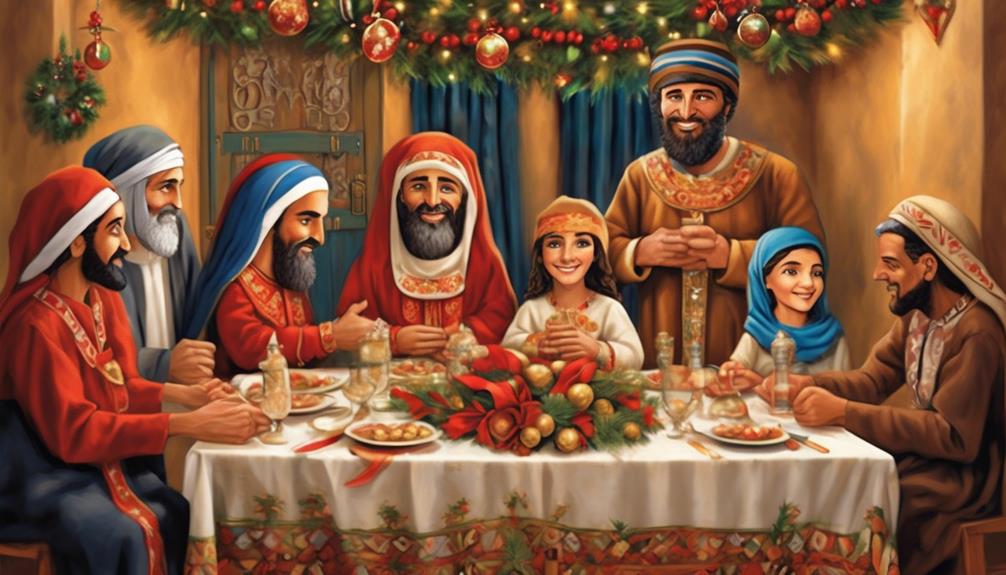
Have you ever wondered about the unique greeting for Coptic Christmas amidst the diverse range of greetings exchanged during the holiday season?
It's a tradition that holds deep cultural significance and carries a special message.
Understanding the origins and meaning behind this greeting can provide valuable insights into the rich tapestry of Coptic Christmas traditions.
Join me as we uncover the mystery behind this heartfelt greeting and its importance in the celebrations.
Key Takeaways
- The Coptic Christmas greeting holds deep cultural and religious significance for the Coptic Orthodox community.
- It plays a pivotal role in connecting individuals within the community and symbolizes the unity and shared celebration of faith and tradition.
- The greeting reflects the rich history and heritage of the Coptic community, embodying themes of love, peace, and unity.
- It fosters a sense of community and belonging, strengthens cultural identity, and forms the foundation of the Coptic Christmas festivities.
Significance of Coptic Christmas Greeting
The Coptic Christmas greeting holds deep cultural and religious significance for the Coptic Orthodox community, signifying the joyous celebration of the birth of Jesus Christ. Beyond its religious importance, this greeting plays a pivotal role in connecting individuals within the community, spreading joy and fostering social connections. It's not just a simple exchange of words; it's a heartfelt expression that transcends generations, binding the community together in a shared celebration of faith and tradition.
The greeting is a symbol of cultural importance, passed down through centuries, and is deeply ingrained in the fabric of Coptic society. As we exchange this greeting, whether with family, friends, or fellow church members, we aren't only acknowledging the birth of Jesus Christ but also reinforcing the bonds that tie us together. This simple yet profound gesture carries the weight of tradition and the warmth of shared beliefs, making it a powerful tool for cultivating a sense of unity and belonging.
In essence, the Coptic Christmas greeting goes beyond mere words; it's a conduit for spreading joy and strengthening social connections within the Coptic Orthodox community, embodying the profound significance and cultural richness of this festive tradition.
Origins of the Coptic Christmas Greeting
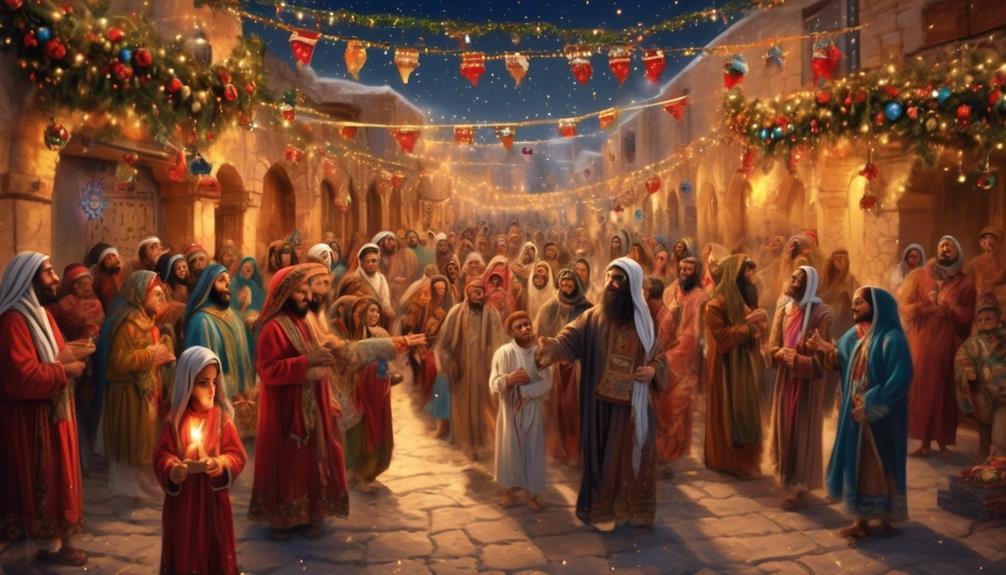
Centuries ago, our ancestors in the Coptic Orthodox community crafted a heartfelt and enduring Christmas greeting that continues to resonate with deep cultural and religious significance today. The origins of the Coptic Christmas greeting can be traced back to the early days of Christianity in Egypt, where it evolved over time to become an integral part of Coptic cultural and religious practices. This greeting has not only survived but has also evolved, adapting to the changing cultural and religious landscape while retaining its core symbolism and meaning. The evolution of the greeting reflects the rich cultural tapestry of the Coptic community and symbolizes the enduring faith and resilience of its people. The table below summarizes the cultural and symbolic significance of the Coptic Christmas greeting:
| Cultural Significance | Symbolism | Evolution |
|---|---|---|
| Deeply rooted in Coptic tradition and community | Represents the enduring faith and resilience of the Coptic people | Adapted to changing cultural and religious landscapes |
The greeting serves as a powerful reminder of the enduring traditions and beliefs that have been passed down through generations, embodying the rich heritage of the Coptic Orthodox community.
Traditional Coptic Christmas Greeting
Crafting a traditional Coptic Christmas greeting involves weaving together cultural and religious symbolism to convey heartfelt wishes and blessings. This greeting is deeply rooted in cultural tradition, reflecting the rich history and heritage of the Coptic community. It's a time-honored expression of joy and goodwill, embodying the spirit of festive celebrations.
The traditional Coptic Christmas greeting encapsulates the essence of the holiday season, encompassing themes of love, peace, and unity. It serves as a heartfelt expression of good wishes, not only for the recipient but for their entire family and community. Through this greeting, we extend warm regards and blessings, acknowledging the significance of this joyous occasion.
Embracing the traditional Coptic Christmas greeting is a cherished practice that fosters a sense of togetherness and belonging within the community. It serves as a reminder of the enduring customs and values that have been passed down through generations, enriching the festive celebrations with profound meaning and significance.
This timeless gesture embodies the essence of the holiday, uniting us in shared joy and goodwill.
Cultural Importance of Greeting in Coptic Christmas

Observing the cultural importance of greeting in Coptic Christmas, we find a tradition deeply intertwined with the fabric of community and heritage. The exchange of greetings during Coptic Christmas is not just a formality; it is a reflection of the cultural traditions and festive celebrations that have been passed down through generations. The act of exchanging greetings brings people together, fostering a sense of belonging and unity within the community. It serves as a reminder of the shared values and beliefs that form the foundation of the Coptic Christmas festivities.
| Cultural Traditions | Importance |
|---|---|
| Exchange of Greetings | Reflects shared values and beliefs |
| Festive Celebrations | Fosters sense of community and belonging |
| Heritage | Strengthens cultural identity |
Spreading Joy With Coptic Christmas Greetings
Spreading joy with Coptic Christmas greetings enhances our sense of community and strengthens our cultural identity. As we exchange these heartfelt greetings, we not only express our joy for the festive season but also foster a deeper connection with our community. Here's how spreading Coptic Christmas greetings can truly bring joy and strengthen cultural exchange:
- Building Bridges: Greetings create an opportunity for cultural exchange, allowing us to share the beauty of our traditions with others.
- Fostering Unity: By spreading joy through greetings, we reinforce a sense of togetherness and solidarity within our community.
- Preserving Traditions: Sharing Coptic Christmas greetings helps preserve our rich cultural heritage and ensures that our traditions continue to thrive.
- Creating Memories: These greetings become cherished memories, adding to the joyful atmosphere of the holiday season for both the sender and the recipient.
- Spreading Happiness: The simple act of exchanging heartfelt greetings spreads happiness and uplifts the spirits of everyone involved, creating a warm and festive atmosphere.
Exchanging Well-Wishes on Coptic Christmas

Exchanging well-wishes on Coptic Christmas brings joy and strengthens our sense of community and cultural identity. It's a time when we come together to exchange blessings and share joy, upholding cherished holiday traditions and cultural rituals. The simple act of wishing someone well on this special day fosters a deeper connection and reinforces the bonds of our community.
As we exchange heartfelt greetings and blessings with family, friends, and even strangers, we're reminded of the beauty of our shared heritage and the warmth of our cultural traditions.
These well-wishes serve as a reminder of the values and principles that unite us, filling our hearts with a sense of belonging and togetherness. Through this exchange, we not only spread joy but also honor the rich tapestry of our cultural identity. It's a beautiful way to celebrate Coptic Christmas, reaffirming our ties to one another and expressing our shared hopes for peace, prosperity, and goodwill.
In these moments of connection and celebration, we find strength and comfort in the embrace of our community, fostering a sense of unity that transcends time and distance.
The Meaning Behind Coptic Christmas Greeting
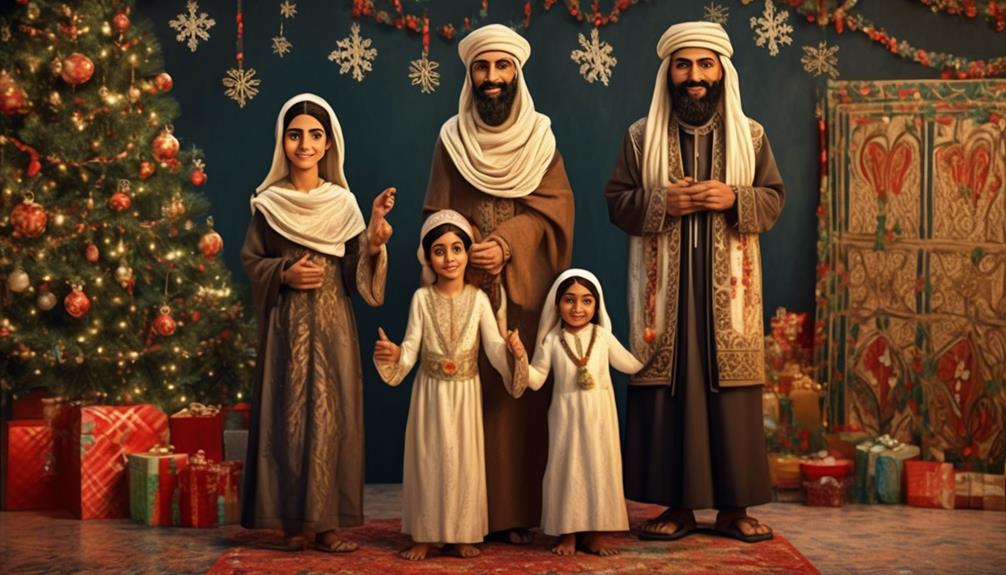
So, let's talk about the meaning behind Coptic Christmas greetings.
The tradition of exchanging well-wishes on Coptic Christmas holds great cultural significance within the Coptic Christian community.
Understanding the deeper meaning behind these greetings can provide insight into the values and beliefs cherished by individuals celebrating this special occasion.
Coptic Christmas Greeting Tradition
The Coptic Christmas greeting tradition holds deep significance within the Coptic Orthodox community, embodying a message of joy, peace, and spiritual renewal. This tradition is a beautiful reflection of our cultural importance and the unity it fosters among us.
Here's why this tradition is so meaningful:
- Spreading Joy: The greetings exchanged during Coptic Christmas are a way of spreading joy and warmth among our community members.
- Well Wishes: It's a time for us to convey heartfelt well wishes for the holiday season and the year ahead.
- Cultural Significance: The tradition reinforces our cultural identity and strengthens our bond as a community.
- Social Connections: It provides an opportunity to strengthen social connections and build camaraderie.
- Unity: By exchanging these greetings, we reinforce the sense of unity and togetherness that's integral to our faith and heritage.
Cultural Significance of Greeting
Celebrating Coptic Christmas through the traditional greeting holds deep cultural significance, embodying the spirit of joy, unity, and spiritual renewal within the Coptic Orthodox community.
The greeting 'El Milad Majid' reflects the cultural traditions and holiday customs of the Coptic Christmas, signifying the birth of Jesus Christ. It serves as a symbol of solidarity, love, and respect among Coptic Christians, fostering a sense of belonging and togetherness during this sacred time.
The exchange of this greeting is a cherished ritual that reinforces the shared values and beliefs of the community, reinforcing the importance of faith and tradition. It's a beautiful expression of the rich cultural heritage and religious devotion that characterize the Coptic Christmas celebration, connecting individuals in a profound and meaningful way.
Coptic Christmas Greeting Customs
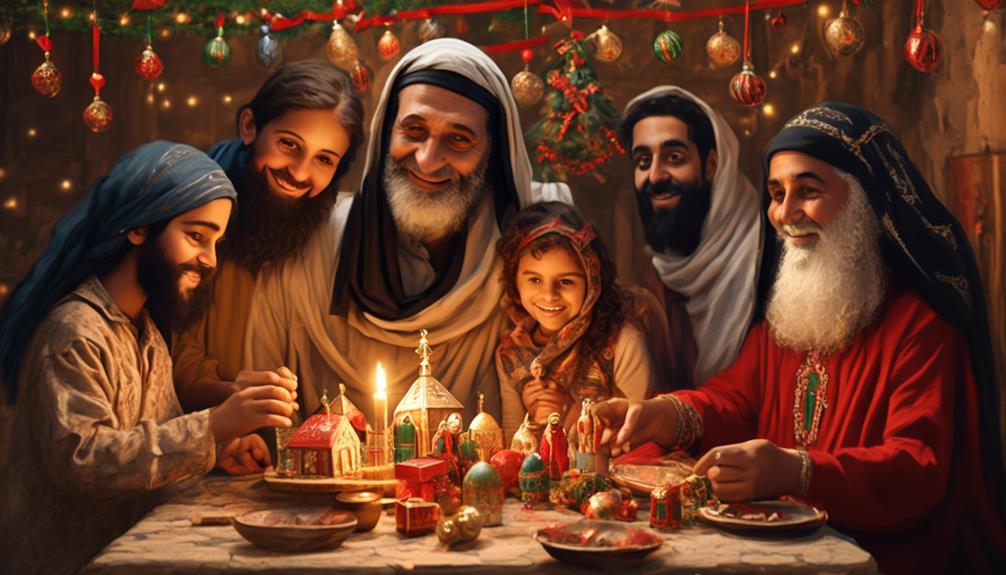
We'll explore the traditional and modern customs of Coptic Christmas greetings.
From the heartfelt traditional greetings passed down through generations to the innovative ways of expressing holiday wishes in today's digital age, Coptic Christmas greetings have evolved with time.
Understanding these customs provides insight into the rich cultural traditions surrounding Coptic Christmas celebrations.
Traditional Coptic Greetings
During the Coptic Christmas season, it's customary to exchange traditional greetings that convey blessings and well-wishes for the occasion. Traditional Coptic greetings hold deep cultural significance and are an integral part of our festive celebrations. When exchanging greetings during Coptic Christmas, consider the following:
- Invoke Blessings: Use phrases such as 'Kul sana wa inta tayeb' (كل سنة و إنت طيب) which means 'May every year find you in good health' to express blessings and well-wishes.
- Embrace Tradition: Emphasize the importance of cultural traditions by using greetings like 'El Milad Majid' (الميلاد مجيد) meaning 'Glorious Birth' to honor the religious and cultural significance of the occasion.
- Share Joy: Spread happiness and joy by greeting with 'Eid Wahda' (عيد واحد) which translates to 'One feast' signifying unity and togetherness during this festive season.
- Express Gratitude: Show appreciation and gratitude by using 'Naharak Saeed' (نهارك سعيد) or 'Nahar en Naby' (نهار النبي) to convey 'Happy Day' or 'Prophet's Day' respectively.
- Spread Love: Capture the essence of love and compassion with 'El Mawlid Sameh' (المولد سعيد) meaning 'Merry Christmas' to share love and joy with others.
Modern Coptic Greetings
Modern Coptic greetings have evolved to incorporate contemporary language and expressions while still upholding the traditional values and sentiments of the occasion. In today's Coptic community, greetings for Christmas have taken on modern practices and cultural expressions that reflect the diverse and dynamic nature of the celebrants. Below is an example of how modern Coptic greetings may appear:
| English | Coptic Transliteration | Coptic Translation |
|---|---|---|
| Merry Christmas! | Colo sana wintom tieb | Happy New Year! |
| Happy Holidays! | Pi'agi ente epnevma | Blessed feast |
| Joy and peace! | Owoot en pi'agi | Joy in the feast |
These modern greetings demonstrate the fusion of traditional Coptic values with contemporary expressions, allowing for a meaningful exchange of warm wishes during the Christmas season.
Sharing Greetings in Coptic Christmas Celebrations
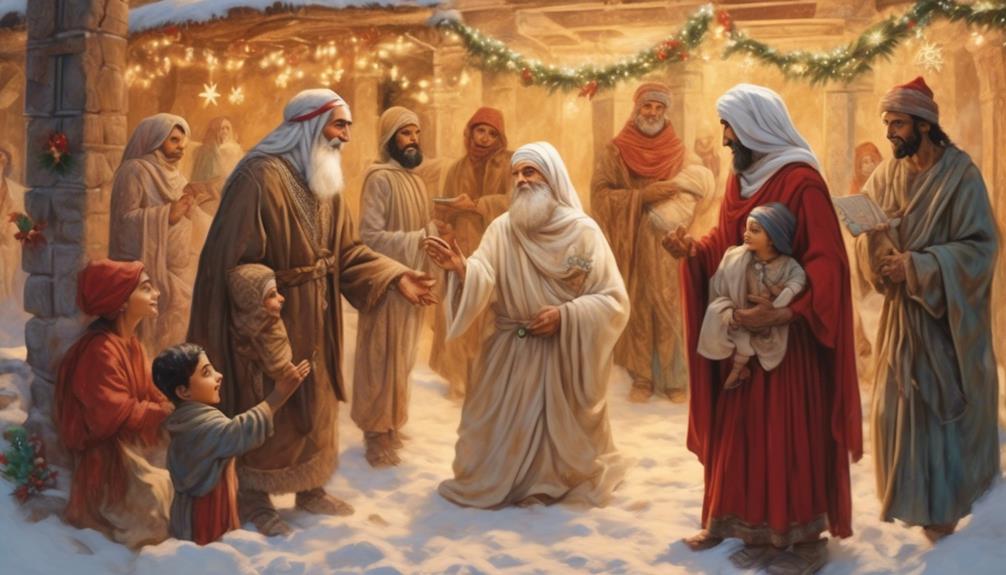
In Coptic Christmas celebrations, exchanging traditional greetings holds a special significance for the community. It's a time when we come together to share joy and blessings with one another.
Here are some key ways we share greetings during this festive time:
- 'Colo sana wintom tiebeen': This traditional Coptic greeting translates to 'May you be well every year' and is commonly used to wish others a blessed and prosperous year ahead.
- Warm Embraces: In our community, hugs and embraces are a common way to express our love and warmth towards each other during the Christmas celebrations.
- Offering Prayers: We often exchange greetings by offering prayers for each other's well-being and happiness during the Christmas season.
- Gift-giving: Sharing gifts is another way we convey our warm wishes and spread joy during the festive season.
- Festive Feasts: Coming together for communal meals and feasting is a time-honored way for us to exchange greetings and celebrate the joyous occasion.
These traditions help us create a sense of togetherness and convey our heartfelt wishes for a wonderful Christmas season.
Impact of Coptic Christmas Greetings
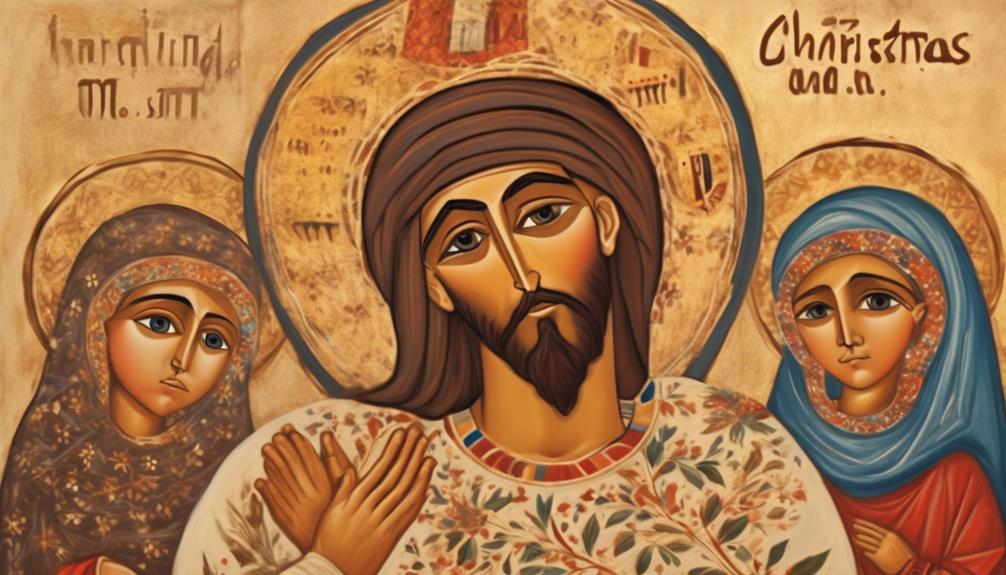
Coptic Christmas greetings carry immense cultural significance, fostering a sense of tradition and heritage within the community. These greetings also serve as a means to strengthen social connections and promote unity among Coptic Christians, creating a sense of belonging and shared identity.
Cultural Significance of Greetings
The tradition of exchanging Coptic Christmas greetings holds deep cultural significance within the Coptic community, fostering a sense of unity and connection during this important holiday. This practice reflects our cultural traditions and reinforces the bonds that tie us together as a community. The impact of Coptic Christmas greetings is substantial, as it serves as a reminder of our shared heritage and faith.
Here are some key points to consider:
- Preservation of Tradition: Greetings uphold our rich cultural heritage.
- Expression of Joy: Festive expressions convey our shared sense of joy and celebration.
- Community Bonding: Greetings strengthen our sense of community and togetherness.
- Cultural Identity: They reinforce our cultural identity and pride.
- Religious Significance: Greetings reflect our shared faith and devotion during this sacred time.
Exchanging Coptic Christmas greetings isn't just a formality; it's a meaningful expression of our shared values and beliefs.
Social Connections and Unity
Exchanging Christmas greetings within the Coptic community fosters a sense of social connection and unity, strengthening our bonds during this festive season.
These greetings serve as a foundation for social bonding, bringing us together in celebration of our shared traditions and beliefs.
When we engage in exchanging heartfelt greetings, we not only express our joy for the holiday but also affirm our belonging to the Coptic community.
This act of community engagement creates an atmosphere of warmth and togetherness, fostering a deep sense of unity among us.
By actively participating in this tradition, we reaffirm our connections to one another, building and reinforcing the strong social fabric that holds our community together.
As we extend and receive these greetings, we're reminded of the interconnectedness that defines us, enhancing the spirit of togetherness that characterizes Coptic Christmas.
Frequently Asked Questions
How Do Coptic Christians Typically Celebrate Christmas?
We typically celebrate Coptic Christmas with joyful gatherings and vibrant traditions. Our festive customs include attending church services, followed by festive meals with family and friends. We exchange gifts and enjoy traditional Coptic dishes.
The celebrations are marked by a sense of community and spiritual reflection. It's a time of togetherness and reverence, and we cherish the traditions that bring us closer to our faith and loved ones.
Are There Any Specific Foods or Dishes Associated With Coptic Christmas Celebrations?
During Coptic Christmas, our festive traditions include enjoying delicious foods like fata, a hearty dish made with rice, bread, and lamb, and kahk, sweet cookies filled with nuts and honey.
These Coptic Christmas foods are cherished by families and friends who gather to celebrate this special time. The flavors and aromas of these dishes embody the spirit of togetherness and joy during the holiday season.
What Are Some Traditional Coptic Christmas Decorations and Symbols?
For traditional decorations, we incorporate symbolic elements like the Nativity scene, known as 'The Crèche,' and images of the Holy Family.
We also adorn our homes with holly, mistletoe, and candles, symbolizing love, luck, and light.
These decorations bring warmth and joy to our celebrations, creating a festive and meaningful atmosphere for Coptic Christmas.
Is There a Specific Date or Time When Coptic Christmas Greetings Are Exchanged?
There isn't a specific date or time for exchanging Coptic Christmas greetings, as it varies depending on regional customs and individual preferences. The greetings hold immense cultural significance and are often exchanged during the Coptic Christmas Eve celebration on January 6th. However, regional variations exist, and some may exchange greetings on January 7th, the official Coptic Christmas Day.
The greetings reflect the warmth and joy of the festive season.
Are There Any Regional Variations in the Way Coptic Christmas Is Celebrated and Greeted?
In terms of regional variations and cultural differences, Coptic Christmas is celebrated and greeted in various ways.
Different regions may have unique traditions, foods, and customs surrounding the holiday.
These variations add richness and diversity to the overall celebration.
It's fascinating to see how people from different backgrounds come together to celebrate this special occasion, each bringing their own unique touch to the festivities.
How Do Coptic Christians Greet Each Other on Christmas?
During Christmas, Coptic Christians greet each other with the traditional Arabic greeting “Eid Milad Majid,” which means “Glorious Birth Feast.” Families gather for a festive meal, exchanging gifts, and decorating with unique Christmas trees, as they celebrate the joyous occasion.
Conclusion
In conclusion, the Coptic Christmas greeting is a cherished tradition that brings joy and unity to the community.
Like a warm embrace on a cold winter's day, the Coptic Christmas greeting spreads love and goodwill among family and friends, strengthening the bonds of faith and culture.
It's a simple yet powerful gesture that reflects the true spirit of the holiday season.
- About the Author
- Latest Posts
Introducing Ron, the home decor aficionado at ByRetreat, whose passion for creating beautiful and inviting spaces is at the heart of his work. With his deep knowledge of home decor and his innate sense of style, Ron brings a wealth of expertise and a keen eye for detail to the ByRetreat team.
Ron’s love for home decor goes beyond aesthetics; he understands that our surroundings play a significant role in our overall well-being and productivity. With this in mind, Ron is dedicated to transforming remote workspaces into havens of comfort, functionality, and beauty.
Chinese New Year Decorations
What Is the Christmas Tree Trend for 2023?

As the holiday season approaches, the twinkling lights and smell of pine are starting to fill our homes, indicating the arrival of Christmas.
But what can we expect for the Christmas tree trend in 2023? With sustainability and eco-consciousness on the rise, this year's tree designs are taking a fresh and innovative approach.
From minimalist and modern to vintage-inspired and nature-themed, the options seem to be evolving.
Join us as we explore the latest Christmas tree trends that are sure to captivate and inspire your holiday decorating endeavors.
Key Takeaways
- Sustainable tree farming practices continue to be a key trend in the Christmas tree industry, focusing on minimizing environmental impact and supporting local ecosystems.
- Minimalist tree designs are gaining popularity, offering simple and elegant aesthetics and space-saving solutions for downsizing holiday decor.
- Modern Christmas tree innovations are incorporating sleek aesthetics, sustainability, and space-saving features, reflecting evolving consumer demands.
- Vintage-inspired tree decor is making a comeback, with retro ornaments, classic tinsel garlands, and antique angel tree toppers adding a nostalgic ambiance and timeless elegance to modern holiday celebrations.
Sustainable Christmas Tree Options
As sustainability becomes an increasingly important consideration for consumers, the demand for eco-friendly Christmas tree options is on the rise. In response to this trend, sustainable tree farming practices are gaining traction. These practices focus on minimizing environmental impact by using organic fertilizers, natural pest control methods, and responsible land management. Sustainable tree farming not only ensures the longevity of tree populations but also supports local ecosystems.
Moreover, reusable tree stands have emerged as a popular choice among environmentally conscious consumers. These tree stands are designed to be durable and long-lasting, allowing them to be used for multiple holiday seasons. By investing in a reusable tree stand, individuals can reduce their contribution to landfill waste generated by the disposal of traditional tree stands each year.
In 2023, the shift towards sustainable Christmas tree options reflects a growing awareness of the environmental impact of holiday traditions. Consumers are actively seeking ways to celebrate the season without compromising the well-being of the planet. Sustainable tree farming and reusable tree stands offer practical and eco-friendly solutions, aligning with the values of conscientious individuals looking to make a positive impact during the holiday season.
Eco-Friendly Tree Decor
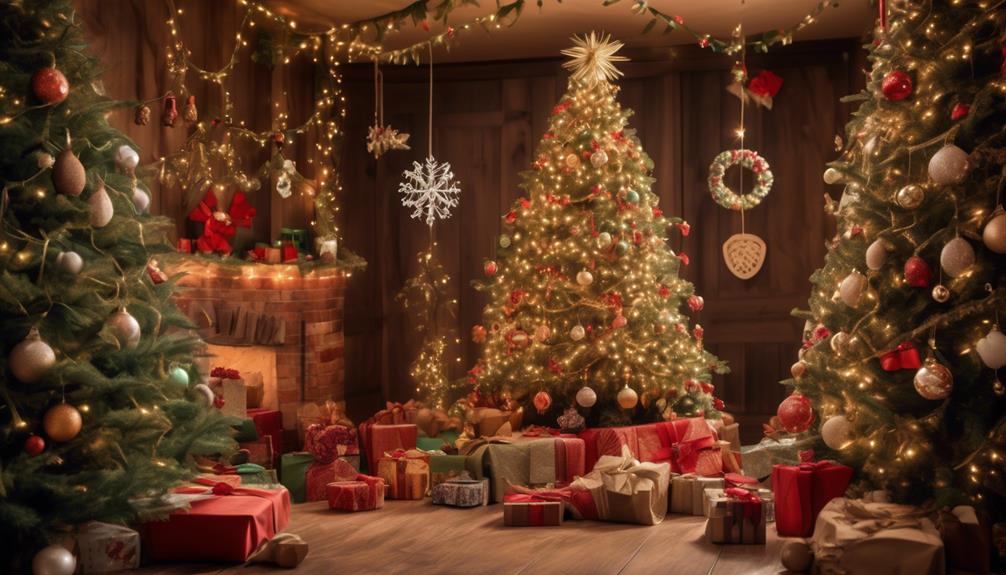
Incorporating eco-friendly tree decor not only complements the sustainable Christmas tree options trend but also enhances the overall environmentally conscious holiday experience. As experts in sustainable holiday trends, we're excited to see the growing popularity of eco-friendly tree decor.
Sustainable ornaments made from recycled materials or natural elements are becoming increasingly sought after, adding a touch of ethical charm to the festive season. These ornaments not only reduce waste but also contribute to a more eco-conscious celebration.
Additionally, eco-friendly tree skirts made from organic fabrics or upcycled materials are gaining traction. They not only provide a beautiful base for the Christmas tree but also align with the sustainability ethos.
Minimalist Tree Designs
We've noticed a rising trend in minimalist Christmas tree designs for 2023. These designs focus on simple and elegant aesthetics, with a strong emphasis on sustainability.
They offer space-saving solutions for those looking to downsize their holiday decor while still making a stylish statement.
Simple, Elegant Designs
For a timeless and sophisticated holiday look, consider opting for a minimalist Christmas tree design with clean lines and subtle decorations.
Embracing natural materials and Scandinavian elegance, this trend embodies simplicity and grace. Choose a tree with a sleek silhouette, such as a slim fir or spruce, to create an elegant focal point in your space.
Keep the color palette muted, using soft tones like white, silver, and light wood to maintain a refined ambiance. Select ornaments and lights with minimalist designs, focusing on quality over quantity.
To enhance sustainability, consider using eco-friendly materials and LED lights. By embracing simplicity and elegance, you can create a serene and stylish holiday atmosphere that exudes a sense of calm and sophistication.
Sustainable Tree Options
As we move into discussing sustainable tree options, particularly within the realm of minimalist designs, the focus on embracing natural materials and eco-friendly choices remains a key aspect of creating a timeless and sophisticated holiday ambiance.
When considering sustainable tree options for the upcoming holiday season, there are several eco-friendly choices that are gaining popularity:
- Tree Rental Services: Opting for tree rental services allows individuals to enjoy the beauty of a real tree without contributing to deforestation. It's a sustainable option that promotes the reuse of trees year after year.
- Live Potted Trees: Choosing live potted trees not only brings a touch of nature indoors but also allows for the tree to be replanted after the holiday season, making it a truly eco-friendly choice.
- DIY Minimalist Tree Designs: Crafting minimalist tree designs using natural and recyclable materials such as wood, twigs, and eco-friendly decorations can significantly reduce environmental impact while achieving a modern and sustainable holiday look.
Space-Saving Solutions
Embracing the trend of space-saving solutions, minimalist tree designs provide a stylish and sustainable option for those seeking to optimize their holiday decor in a modern and eco-friendly manner.
Space-saving storage is a key consideration for many individuals, especially those living in smaller homes or apartments. Innovative designs in minimalist trees offer a practical solution, often featuring slim profiles, collapsible structures, and wall-mounted options. These trees not only save space during the festive season but also make storage hassle-free once the holidays are over.
With a focus on simplicity and functionality, these designs cater to the growing demand for versatile and compact holiday decor. By incorporating minimalist tree designs, individuals can enjoy the festive spirit without compromising on style or sustainability, making it an ideal choice for those looking to maximize their living space.
Modern Christmas Tree Innovations

Innovation has transformed modern Christmas trees, introducing sustainable materials and space-saving designs. As experts in the field, we've been closely monitoring the latest trends and have identified the most exciting modern Christmas tree innovations for 2023.
Here's what's shaking up the traditional tree scene:
- Futuristic Tree Designs:
Embracing a sleek, minimalist aesthetic, futuristic tree designs are gaining popularity. These trees often feature unconventional materials like metal and glass, and their innovative lighting creates a mesmerizing display that captivates the eye.
- Sustainable Tree Alternatives:
In line with the growing sustainability movement, modern Christmas trees are now being crafted from eco-friendly materials such as recycled wood, cardboard, and even repurposed plastics. These sustainable alternatives not only reduce environmental impact but also add a unique, contemporary flair to holiday decor.
- Space-Saving Innovations:
Recognizing the need for practicality in today's living spaces, modern Christmas trees are being designed with compactness in mind. From wall-mounted trees to collapsible options, these space-saving innovations allow for festive celebrations without compromising on precious room real estate.
These modern Christmas tree innovations reflect the evolving demands of consumers for sustainable, space-efficient, and visually striking holiday decor.
Vintage-Inspired Tree Decor
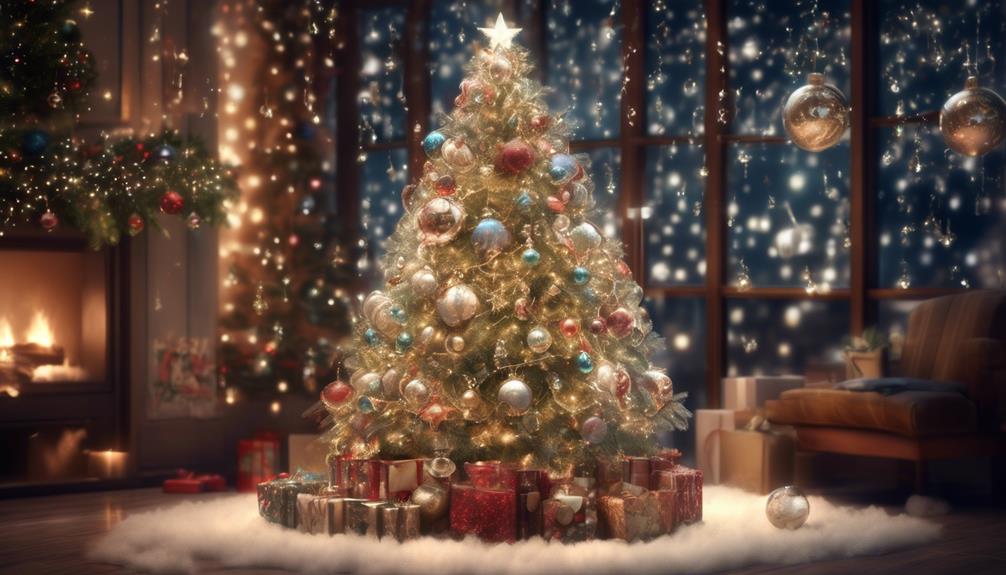
We've noticed a growing interest in vintage-inspired tree decor for the upcoming holiday season. Retro ornaments and lights, classic tinsel garlands, and antique angel tree toppers are making a comeback in a big way.
This trend not only adds a touch of nostalgia to our Christmas trees but also promotes sustainability by repurposing and reusing timeless decorations.
Retro Ornaments and Lights
Incorporating retro ornaments and vintage-inspired lights into your Christmas tree décor adds a nostalgic touch and timeless charm to your holiday celebrations. The trend for 2023 is all about embracing the classic appeal of yesteryears. Here's why you should consider incorporating retro ornaments and vintage-inspired lights:
- Nostalgic Ambiance: Retro tinsel and vintage baubles evoke heartwarming memories, creating a cozy and nostalgic ambiance in your home.
- Timeless Elegance: Vintage-inspired lights bring a timeless elegance to your tree, adding a touch of sophistication and grace to your holiday décor.
- Sustainability: Embracing retro ornaments and vintage-inspired lights aligns with sustainable practices by reusing and repurposing items, contributing to a more eco-friendly approach to holiday decorating.
With a nod to the past and a sustainable mindset, incorporating retro ornaments and vintage-inspired lights into your Christmas tree décor is the perfect way to infuse your celebrations with warmth and charm.
Classic Tinsel Garlands
Embracing classic tinsel garlands as part of your vintage-inspired tree decor infuses a timeless elegance into your holiday celebrations. Tinsel, with its shimmering strands, has made a remarkable comeback, adding a touch of nostalgia to modern holiday decor. When considering tinsel alternatives, look for sustainable options such as recycled materials or biodegradable alternatives to minimize environmental impact. Modern tree toppers like vintage-inspired angels or handcrafted starbursts beautifully complement classic tinsel garlands, enhancing the nostalgic ambiance. To evoke a sense of intimacy, we've curated a table featuring the emotional appeal of classic tinsel garlands:
| Emotion | Description | Example |
|---|---|---|
| Nostalgia | Elicits fond memories | Family heirloom tinsel |
| Warmth | Creates cozy atmosphere | Soft, glowing tinsel |
| Joy | Evokes feelings of happiness | Shimmering silver tinsel |
| Elegance | Adds a touch of sophistication | Gold-threaded tinsel |
Classic tinsel garlands not only bring traditional charm but also contribute to sustainable, eco-friendly holiday decor.
Antique Angel Tree Topper
Antique angel tree toppers are making a significant resurgence in the realm of vintage-inspired tree decor, adding a touch of timeless elegance to modern holiday celebrations. These antique angels bring a sense of nostalgia and tradition to the festive season, making them a cherished addition to any Christmas tree.
Here's why antique angel tree toppers are the latest trend for vintage-inspired decor:
- Timeless Elegance: Antique angel tree toppers exude a classic charm that elevates the overall aesthetic of the tree.
- Sentimental Value: These vintage-inspired decor pieces often carry sentimental value, evoking cherished memories and family traditions.
- Sustainable Option: Opting for antique angel tree toppers promotes sustainability by repurposing and appreciating timeless pieces, reducing the need for new decorations.
With their timeless appeal and sentimental significance, antique angel tree toppers are becoming a beloved choice for vintage-inspired holiday decor.
Creative DIY Tree Ornaments
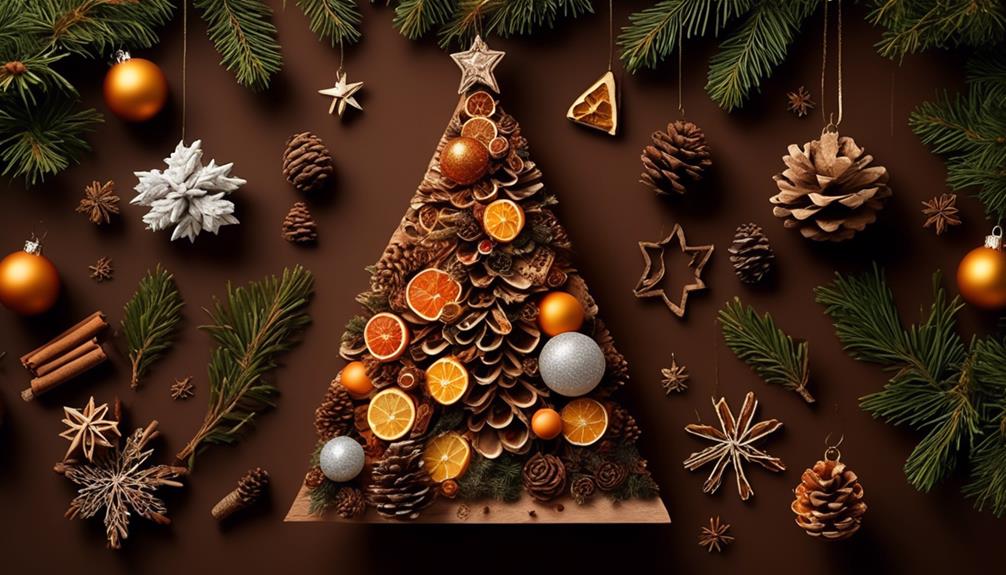
To create a unique and sustainable Christmas tree, consider crafting your own DIY ornaments using eco-friendly materials and personalized touches. DIY ornament ideas offer a perfect way to infuse your tree with creativity and reduce waste by upcycling items into beautiful decorations. Here are some inspiring ideas for DIY Christmas tree ornaments:
| Ornament | Materials Needed | How to Make It |
|---|---|---|
| Pinecone Reindeer | Pinecones, pipe cleaners, small red pom-poms, googly eyes, ribbon | Twist pipe cleaners around the pinecone to create antlers, then glue on googly eyes and pom-pom for the nose. Attach a ribbon for hanging. |
| Scrabble Tile Initials | Scrabble tiles, ribbon | Glue the Scrabble tiles together to form initials or meaningful words. Attach a ribbon for hanging. |
| Fabric Scrap Ornaments | Fabric scraps, embroidery hoops, yarn | Place fabric in the embroidery hoop, tie with yarn, and trim excess fabric. Hang with a festive ribbon. |
These DIY ornaments not only add a personal touch to your tree but also contribute to sustainability by using repurposed materials. Get creative and enjoy making these unique ornaments for a more meaningful and eco-conscious holiday season.
Tech-Integrated Tree Lighting

We've seen a surge in smart lighting options for Christmas trees, allowing for customizable displays and energy efficiency.
With voice-controlled tree lights and interactive light displays, technology is seamlessly integrated into the holiday tradition of decorating a Christmas tree.
This trend not only adds a modern touch to the festivities but also promotes sustainability through the use of energy-saving LED lights and programmable features.
Smart Lighting Options
One exciting trend in Christmas tree decorating for 2023 is the integration of smart lighting options, offering a modern and innovative approach to illuminating your tree. This trend not only brings a touch of technology to your holiday decor but also provides practical benefits such as energy efficiency and convenience.
Here are the top smart lighting options to consider for your Christmas tree:
- Energy Efficient Bulbs: Smart LED lights aren't only vibrant and customizable but also use significantly less energy than traditional incandescent bulbs, reducing your environmental impact.
- Wireless Control Options: With wireless control capabilities, you can easily adjust the brightness, color, and patterns of your tree lights using a smartphone app or voice commands, adding convenience and flexibility to your holiday decorating.
- Smart Automation Features: Some smart lighting systems offer automation features, allowing you to schedule lighting patterns or integrate them with other smart home devices for a seamless holiday experience.
Embracing smart lighting options for your Christmas tree not only enhances the aesthetics of your holiday decor but also aligns with sustainable and modern living.
Voice-Controlled Tree Lights
After exploring energy-efficient bulbs and wireless control options in smart lighting for Christmas trees, the next frontier in tree illumination is the integration of voice-controlled tree lights, marking a significant advancement in tech-integrated tree lighting for the upcoming holiday season.
With personalized lighting becoming increasingly popular, voice-activated decorations offer a seamless and hands-free way to customize the ambiance of your Christmas tree. Imagine simply speaking a command to adjust the colors, brightness, or lighting effects without the need to fiddle with switches or apps.
This innovative technology not only adds convenience but also aligns with sustainability efforts by promoting efficient energy usage. As the demand for interactive and eco-friendly holiday decor grows, voice-controlled tree lights are set to revolutionize the way we adorn and illuminate our festive trees, providing a more personalized and enchanting experience for the holiday season.
Interactive Light Displays
As we delve into the realm of tech-integrated tree lighting, interactive light displays are emerging as a captivating and sustainable trend for the upcoming holiday season. These innovative displays offer energy-efficient options, such as LED lights and programmable features, reducing environmental impact while enhancing visual appeal.
Additionally, interactive projection mapping allows for dynamic and customizable lighting experiences, creating a mesmerizing atmosphere in any space. Outdoor installations bring a touch of magic to exterior settings, engaging viewers with enchanting light shows.
Furthermore, interactive music synchronization adds an extra dimension to the displays, syncing lights with music to create a symphony of sight and sound. With these developments, interactive light displays aren't only elevating the holiday ambiance but also contributing to a more sustainable and immersive festive experience.
Customizable Tree Trends

The trend for customizable Christmas trees in 2023 reflects a growing demand for personalized and sustainable holiday decor options. Personalized ornaments and themed tree skirts are at the forefront of this trend, allowing individuals to express their unique style and values through their festive displays. This trend aligns with the increasing focus on sustainability, as it encourages the reuse of ornaments and tree skirts year after year, reducing waste and promoting mindful consumption.
Customizable trees provide a delightful opportunity for families to come together and create cherished memories while decorating. Whether it's incorporating homemade ornaments that hold sentimental value or choosing a theme that reflects a shared passion, the customizable tree trend fosters togetherness and meaningful connections during the holiday season.
Moreover, this trend promotes individuality and self-expression, empowering people to curate a holiday aesthetic that resonates with their personal tastes. By embracing customizable Christmas trees, households can infuse their spaces with warmth and character, enhancing the joy and magic of the season.
Nature-Inspired Tree Themes
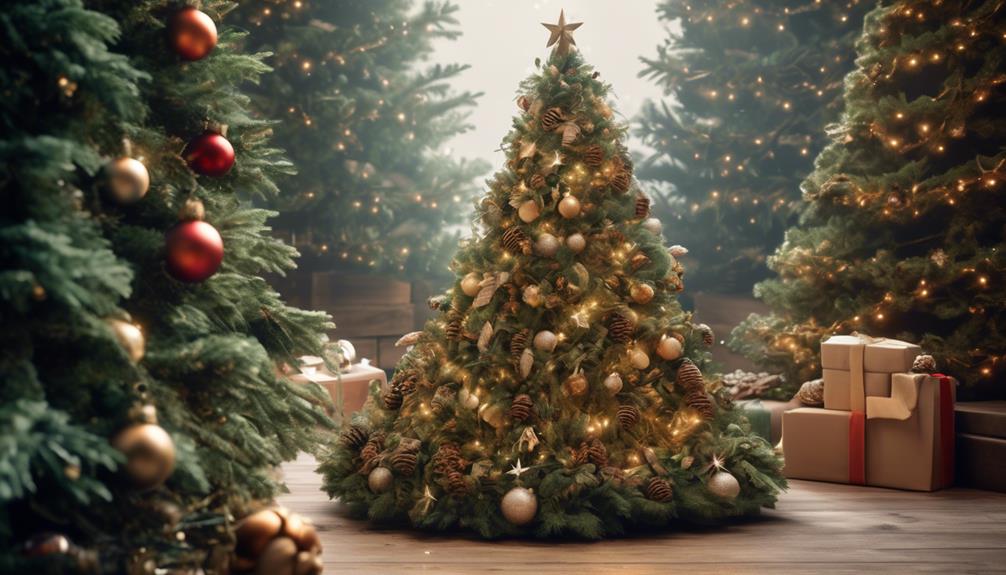
Nature-inspired tree themes offer a refreshing and sustainable approach to holiday decor, drawing inspiration from the beauty and tranquility of the natural world. Embracing botanical themed tree decorations and natural tree ornaments, this trend brings the outdoors inside, creating a sense of calm and connection with nature. Forest inspired tree designs and woodland tree decor further enhance this theme, incorporating elements like pinecones, wood slices, and earthy colors to evoke the peaceful ambiance of a forest.
Why Nature-Inspired Tree Themes Are Trending:
- Sustainability: By utilizing natural elements, this trend promotes eco-friendly practices, aligning with the growing interest in sustainable living.
- Tranquility: The use of forest-inspired designs and botanical elements creates a serene and peaceful atmosphere, offering a refreshing break from the hustle and bustle of the holiday season.
- Timelessness: Nature-inspired decorations bring a timeless elegance to holiday decor, making them a versatile choice for any home aesthetic.
Incorporating nature-inspired tree themes not only adds a touch of natural beauty to your holiday decor, but also contributes to a more sustainable and calming festive environment.
Non-Traditional Tree Alternatives
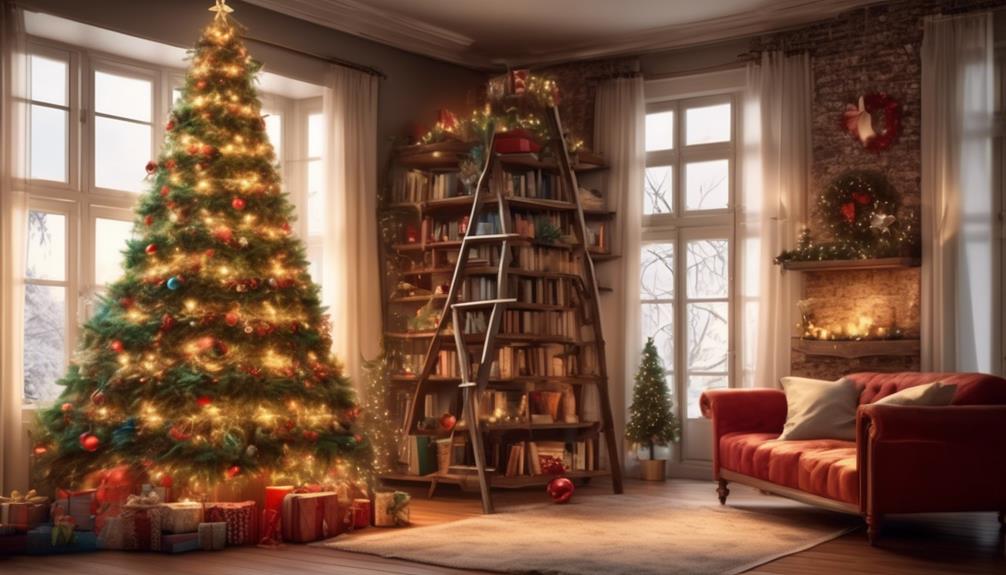
Pioneering a departure from traditional tree decor, the demand for innovative and sustainable holiday alternatives has led to a surge in interest for non-traditional tree options. Artistic tree sculptures and sustainable designs are gaining popularity as non-traditional tree art and eco-friendly installations become more sought after. These alternatives offer a fresh, modern take on the traditional Christmas tree, appealing to individuals looking for unique, environmentally conscious options.
Artistic tree sculptures are redefining holiday décor, offering a blend of artistry and festive spirit. These sculptures come in various materials, from metal to recycled wood, and can be customized to fit any space. They provide a captivating focal point for holiday gatherings, infusing the space with creativity and elegance.
Moreover, sustainable designs are making waves as eco-friendly installations take center stage. From upcycled materials to minimalist, reusable structures, these non-traditional tree alternatives cater to the environmentally conscious consumer. They not only reduce waste but also promote a more sustainable approach to holiday decorating, aligning with the growing trend of eco-conscious living.
As the demand for non-traditional tree alternatives continues to rise, the market is abuzz with innovative, sustainable options that offer a delightful departure from the conventional Christmas tree.
Timeless Classic Tree Decor
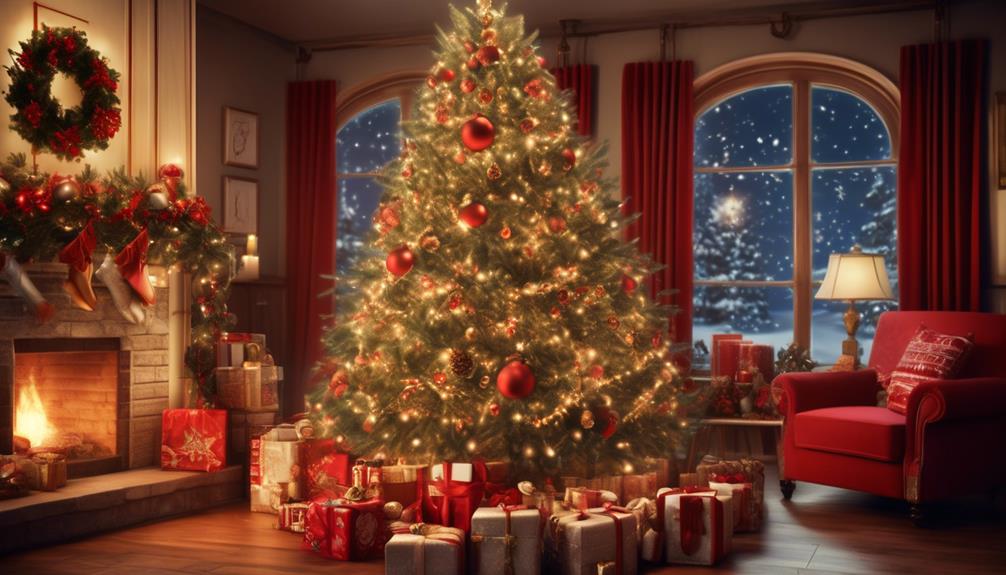
Embracing the enduring appeal of traditional tree decor, we find a timeless elegance that adds a touch of nostalgia to holiday celebrations. The classic tree decor trend for 2023 focuses on elegant simplicity and traditional charm, bringing warmth and familiarity to the holiday season.
Here are three key elements of timeless classic tree decor:
- Traditional Ornaments: Adorning the tree with heirloom ornaments, handmade crafts, and vintage baubles creates a sense of tradition and history. These timeless pieces evoke cherished memories and create a cozy atmosphere in the home.
- Warm White Lights: Opting for warm white string lights adds a soft and inviting glow to the tree, enhancing its classic and timeless appeal. These lights create an enchanting ambiance that complements the traditional charm of the decor.
- Classic Tree Topper: A traditional tree topper, such as a star, angel, or ribbon, provides a finishing touch to the tree, exuding elegance and grace. It adds a nostalgic touch and completes the overall look with a timeless flair.
Incorporating these elements into your Christmas tree decor for 2023 will infuse your home with a sense of enduring tradition and timeless beauty.
Frequently Asked Questions
How Can I Recycle My Old Artificial Christmas Tree in an Eco-Friendly Way?
When it comes to recycling an old artificial Christmas tree in an eco-friendly way, there are some great options to consider.
Upcycling ideas include turning the tree into smaller decorations or repurposing the branches for crafts.
Additionally, you could explore donation options with local organizations or schools that may be in need of holiday decorations.
It's a sustainable way to give your tree new life and spread some festive cheer.
What Are Some Ways to Incorporate Sustainable Materials Into My Christmas Tree Decorations?
We've been exploring ways to make our Christmas tree decorations sustainable.
One idea is to use eco-friendly ornaments made from recycled materials or natural elements like wood, cork, or dried citrus slices.
Another way is to incorporate natural fiber garlands, such as jute or hemp, which not only look beautiful but are also biodegradable.
These sustainable materials not only bring a cozy, rustic charm to our tree but also contribute to reducing environmental impact.
Are There Any Minimalist Tree Designs That Also Incorporate Sustainable or Eco-Friendly Elements?
Absolutely! We're seeing a rise in minimalist designs for Christmas trees that incorporate eco-friendly elements. Think sleek, unadorned trees adorned with sustainable ornaments like wooden or felt decorations, LED lights, and recycled materials.
Embracing simplicity and sustainability, these trees aren't only aesthetically pleasing but also align with eco-conscious values. It's a trend that's gaining popularity as people seek to celebrate the holidays in a more environmentally friendly way.
What Modern Innovations Are Available for Christmas Trees That Are Also Environmentally Friendly?
When it comes to modern innovations for environmentally friendly Christmas trees, we're seeing a rise in solar-powered lights and biodegradable ornaments.
This trend not only adds a touch of sustainability to the festive season but also embraces the latest technological advancements.
How Can I Create Vintage-Inspired Tree Decor Using Repurposed or Recycled Materials?
To create vintage-inspired tree decor using repurposed or recycled materials, we often start by scouring flea markets or thrift stores for unique ornaments. These repurposed ornaments add character and charm to the tree.
For a vintage DIY tree topper, consider crafting one using old lace, fabric, or even repurposed jewelry.
It's all about infusing nostalgia and sustainability into your holiday decorations, creating a timeless and eco-friendly festive ambiance.
Is the Christmas Tree Trend for 2023 available at the Biggest Christmas Store?
Yes, the Christmas Tree Trend for 2023 is indeed available at the biggest Christmas store. With a wide range of sizes, styles, and decor options, you can find the perfect tree to suit your festive vision at the biggest Christmas store.
Conclusion
As we look ahead to the Christmas tree trends for 2023, it's clear that sustainability and creativity will be at the forefront.
From eco-friendly options to minimalist designs and modern innovations, there's a trend for everyone.
Whether you're drawn to vintage-inspired decor or nature-inspired themes, there's no shortage of customizable and non-traditional alternatives to choose from.
With timeless classics making a comeback, the Christmas tree of 2023 is sure to be a reflection of individual style and eco-conscious choices.
- About the Author
- Latest Posts
Introducing Ron, the home decor aficionado at ByRetreat, whose passion for creating beautiful and inviting spaces is at the heart of his work. With his deep knowledge of home decor and his innate sense of style, Ron brings a wealth of expertise and a keen eye for detail to the ByRetreat team.
Ron’s love for home decor goes beyond aesthetics; he understands that our surroundings play a significant role in our overall well-being and productivity. With this in mind, Ron is dedicated to transforming remote workspaces into havens of comfort, functionality, and beauty.
-

 Vetted2 days ago
Vetted2 days ago15 Best Plants for Large Pots to Transform Your Outdoor Space
-

 Vetted17 hours ago
Vetted17 hours ago15 Best Fairy Lights to Transform Your Space With Magical Illumination
-

 Vetted4 days ago
Vetted4 days ago15 Best Folding Beds for Small Spaces – Space-Saving Solutions for Comfort and Convenience
-

 Vetted3 days ago
Vetted3 days ago15 Best Waterproof Flooring Options for Your Bathroom – Ultimate Guide & Reviews
-

 Vetted1 week ago
Vetted1 week ago15 Best Grocery Carts to Make Shopping a Breeze
-

 Vetted2 weeks ago
Vetted2 weeks ago15 Best Gravel for Driveway: The Ultimate Guide for a Durable and Stunning Entrance
-

 Vetted6 days ago
Vetted6 days ago15 Best Steam Generators for Showering Bliss: Reviewed & Rated
-

 Beginners Guides4 weeks ago
Beginners Guides4 weeks agoI Inhaled Vinegar Fumes

























